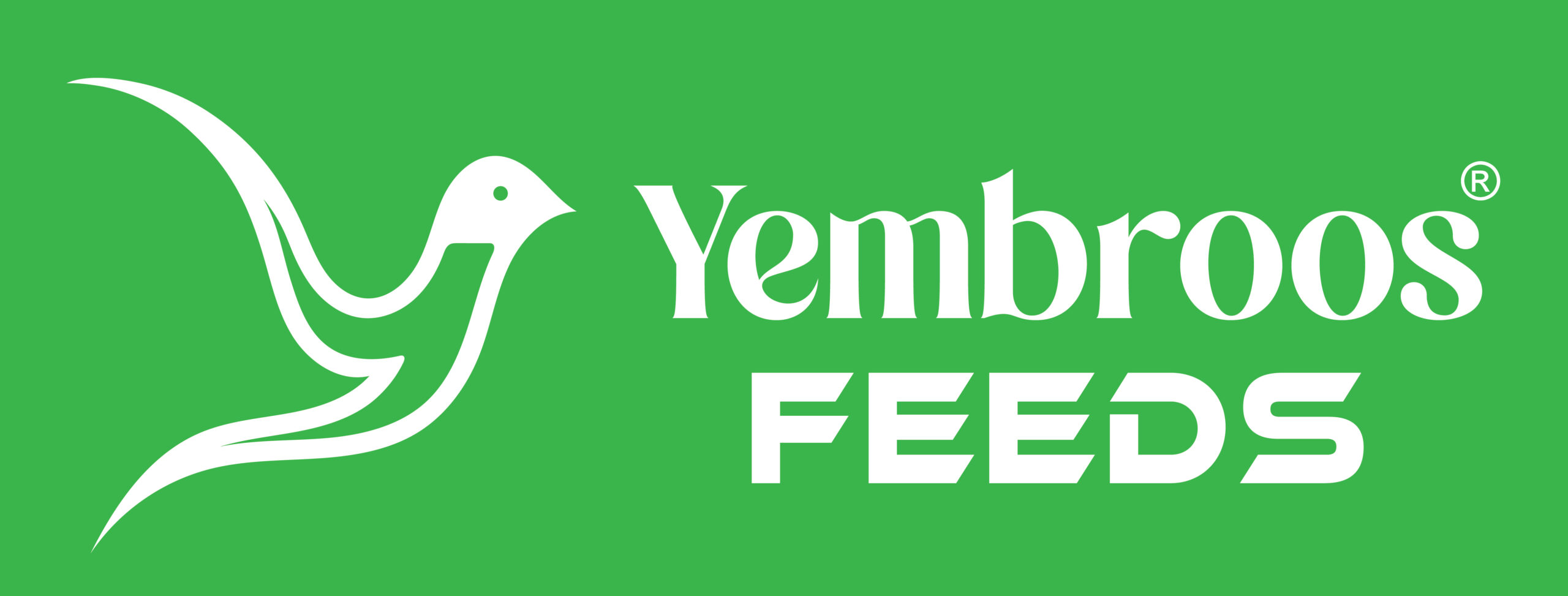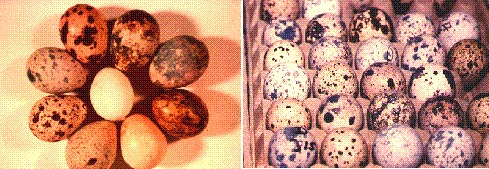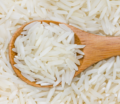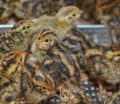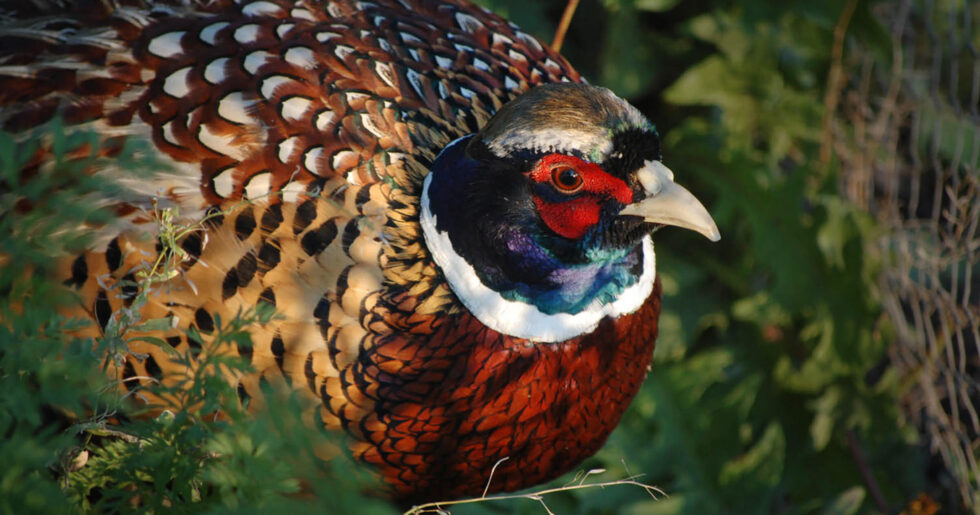
Bobwhite Quail (Colinus virginianus)
The popular Bobwhite Quail is a favorite of game bird breeders, hunters and bird lovers alike. Just about everyone is familiar with male’s call for which the species is named. These plump little birds have the most widespread range of any quail species, with over 20 subspecies ranging from Canada to southern Mexico. They have also been introduced abroad, to such places as Hawaii and New Zealand, as a game species. Commercial game bird farms raise thousands each year for release in the US and Canada.
Of the subspecies, the Eastern Bobwhite (C. v. viriginaus), is the most often kept and seen. They are found in a variety of habitats, from open woodlands & fields to suburban parks. Those with bird feeders in their yards are sometimes greeted a few quail who come to feed on the seed that is dropped by the other birds. Males have a white throat and eye-line, with a dark crown and a black line that separates the white on the throat to the eye-line. The lower breast is mottled white & dark brown; sides have light brown streaks and the back and rest of the body mottled brown overall; tail gray. The hens are similar, but her throat and eye-line is buff and her overall color is somewhat lighter. They form large groups during the winter called coveys. These coveys can consist of up to 30 or more birds and when disturbed, all will burst into flight at once.
A rarer subspecies, the Masked Bobwhite (C. v. ridgwayi), is native to the Southwest. They are popular with breeders in captivity, but remain on the Endangered Species List in the wild. These birds are similar to the eastern race, but males have a very dark face & throat. They also appear darker overall.
The further south you travel into Mexico, the Bobwhite subspecies differ a great deal from the northern counterparts. Many have much more white on the throats and a more detailed barring on the breast. It is a shame that some of these races have yet make their way to our aviaries, as they are beautiful birds. Perhaps in the future, some may make their way and become established in captivity.
Breeding
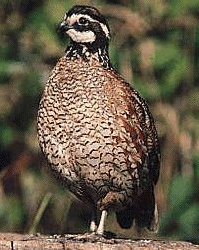
Healthy and vibrant Bobwhite Quail – ideal candidate for Yembroos® Breeding Game Bird Feed
Bobwhites present no problems in captive rearing, and can be produced easily in modest surroundings or large aviaries. Many producers house their breeders in breeding batteries, some as small as 1′x1′x1′ and keep them in trios or pairs. These batteries are designed to allow the keeper to feed, water and gather eggs (sloped flooring) without entering the cage. We have had success keeping our quail in larger wire bottom cages, usually about 2′x3′x2′ with roosts and material for nesting. We also kept a pair in large flight aviary with other birds one year and they did very well. You can choose to colony mate (several hens with two or three males), trios (one male with two hens) or in pairs.
Bobwhite hens begin laying in mid April and may lay all summer long. The eggs are pure white and are incubated for 21 days. You will probably have to use artificial incubation with this species, as many captive hens are mass producers of eggs are highly unlikely to go broody in a cage setting. Bobwhites are also induced into laying earlier than normal using artificial light. Some larger farms also use the lights to have hens produce eggs year round.
Chicks are easy to raise in the brooder. They require a high protein diet and lots of room, as they are very active and prone to picking if overcrowded. The chicks are kept in a brooder setting for about six weeks, then they are moved to covered, outdoor enclosure.
General Comments
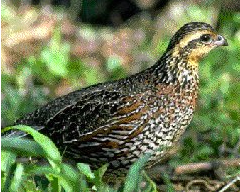 As mentioned, Bobwhites are easy to keep and raise. They are often one of the first species of quail for the beginning quail breeder and many long-time breeders keep them around for the male’s call. Like many other species of quail, they seem to do best on wire, but can be kept on the ground if the aviary is well-drained.
As mentioned, Bobwhites are easy to keep and raise. They are often one of the first species of quail for the beginning quail breeder and many long-time breeders keep them around for the male’s call. Like many other species of quail, they seem to do best on wire, but can be kept on the ground if the aviary is well-drained.
During the Winter, birds that are not kept indoors such as a barn, should be grouped together so they can form natural coveys for warmth. I also recommend keeping dry straw or hay in the cage during the Winter.
Bobwhite should be fed a good quality game bird ration of at least 16% protein during the non-breeding season to 20% during the laying period. I also supplement their diet with various grains, greens and mealworms.
Mutations
There have been a number of mutations developed in captivity. Some of the popular colors include the Mexican Speckled, the Tennessee Red, White and Silver Bobwhites. There are also strains developed for their large size, such as the Wisconsin Jumbo and the Indiana Giant. I will add a more complete description of the mutations and perhaps another page for them at a later date. Care and breeding of the various mutations is the same as the normal Bobwhite.
Japanese quails are produced mainly for their eggs and meat. Starters from day-old to four weeks of age are reared in brooder cages provided with strong lighting to give heat. They are fed 3 times daily with quail starter mesh. Growers and layers are from four weeks to about one year old. They are housed in layer cages which are 5 or 6-tiered. They are fed with quail layer or breeder feed twice daily. Lighting is left on during the night to stimulated the birds to lay eggs. The nutritional requirements of Japanese quail for protein, amino acids, vitamins and minerals will be discussed.
History of The Japanese (Coturnix) Quails
Quail belong, along with chickens, pheasants and partridges to the Family Phasianoidea of Order Galliformes of the Class Aves of the Animal Kingdom. Species or subspecies of the genus Coturnix are native to all continents except the Americas. One of them Coturnix coturnix or common quail are migratory birds of Asia, Africa and Europe. Several interbreeding subspecies are recognized, the more important being the European quail, Coturnix coturnix coturnix, and the Asiatic or Japanese quail, Coturnix coturnix japonica. One subspecies that commonly migrates between Europe and Asia was eventually domesticated in China. These birds were raised as pets and singing birds. The domesticated coturnix were brought at about eleventh century to Japan from China across the Korean bridge (Howes, 1964). In any event, coturnix were first domesticated in the Orient and not in the Middle East as has been claimed by some authors. Although European coturnix migrating south in the fall across the Mediterranean Sea were, in their exhausted condition, easily caught or trapped the available Egyptian and Biblical records do not indicate that these birds were ever bred in captivity.
The first written records of domesticated quail in Japan date from the twelfth century. These birds were initially developed for song. It is claimed that a Japanese Emperor obtained relief from tuberculosis after eating quail meat, and this led to selection of domestic quail for meat and egg production in Japan in the latter part of the nineteenth century (Howes, 1964). By 1910, the Japanese quail in Japan were widely cultured for their meat and eggs. Between 1910 and 1941, the population of Japanese quail increased rapidly in Japan especially in the Tokyo, Mishima, Nagoya, Gifu and Toyohashi areas. This period also represented a time of imperial expansion in Japanese history and domesticated Japanese quail were established in Korea, China, Taiwan an d Hong Kong, and later on spread to Southeast Asia.
The domesticated subspecies, Coturnix coturnix japonica, is called Japanese quail but is also known by other names: Common quail, Eastern quail, Asiatic quail, Stubble quail, Pharaoh’s quail, Red-throat quail, Japanese gray quail, Japanese migratory quail, King quail, and Japanese King quail. The correct popular nomenclature for Coturnix coturnix japonica should be Japanese quail or coturnix, but not coturnix quail since in Latin “coturnix” may be translated as quail.
Description
Coturnix Chick:

Young coturnix are yellowish in appearance with stripes of brown and somewhat resemble turkey poults except for size. The newly hatched chicks weigh about 6 to 7 grams, but grow rapidly during the first few days. After three days flight feathers begin to appear and the birds are fully feathered about four weeks of age. Partial sexing is possible by three weeks of age by the cinnamon-colored feathers on the breast of the male bird, but there are some birds that defy definite sexing by this method, eve n when adults.
Adult Male:
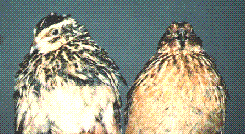 Male (right) and Female (left) Quails
Male (right) and Female (left) Quails
The adult male coturnix weighs about 100 to 140 grams (3 1/2 to 5 ounces). The male birds can be identified readily by the rusty brown colored feathers on the upper throat and lower breast region. Males also have a cloacal gland, a bulbous structure located at the upper edge of the vent which secretes a white, foamy material. This unique gland can be used to assess the reproductive fitness of the males (Cheng, Hickman and McIntyre (1985). The young birds begin to crow at 5 to 6 weeks old. Sanford (19 57) described the voice of the male as a loud, castanet-like crow, producing sound as “pick-per awick” or “ko-turro-neex”. During the height of the normal breeding season, coturnix males will crow throughout the night.
Adult Female:
The adult female coturnix are slightly heavier than the male, weighing from 120 to 160 grams (4 to 5 1/2 ounces). The body coloration of the female bird is similar to the male except that the feathers on the throat and upper breast are long, pointed, an d much lighter cinnamon. Also, the light tan breast feathers are characteristically black-stippled.
Quail Eggs:
Coturnix eggs are characterized by a variety of color patterns. They range from snow white to completely brown. More commonly they are tan and dark brown speckled or mottled brown with a chalky blue covering. The average egg from mature female weighs a bout 10 grams (1/3 ounce), about 8 percent of the body weight of the quail hen as compared to 3 percent for chicken eggs. The egg of Japanese quail contains 158 Cal. of energy, 74.6% water, 13.1% protein, 11.2% fat, and 1.1% total ash. The mineral content includes 0.59 mg calcium, 220 mg phosphorus and 3.8 mg iron. The vitamin content is 300 i.u. of vitamin A, 0.12 mg of vitamin B1, 0.85 mg of vitamin B2 and 0.10 mg nicotinic acid.
Pre-incubation Egg Care:
Successful quail propagation begins in the pre-incubation period. Eggs should be collected twice daily and more frequently in hot weather. Special care must be taken in collecting and handling quail eggs for they are thin-shelled, break more easily than chicken eggs. Eggs should be of a uniform size – extreme large or small size eggs has low hatchability. Eggs held for incubation should be kept in a cool, clean, dust-free room at a temperature of 14 + 3ºC (55 + 5ºF) and 70 + 10 percent relative humidity. Eggs should be stored large end up and they should not be held for more than 7 days before being placed in the incubator. Set only clean eggs. Eggs to be incubated should not be washed; if cleaning is required, it should be done with a clean abrasive or sandpaper. The egg is mostly water and quail egg dehydrates more rapidly. Eggs stored in PVC bags may be stored for a longer period of time (14-21 days) and the hatch will be higher than from unpackaged eggs stored as described above.
Natural Incubation:
Although it is possible to incubate quail eggs under a broody hen or bantam, it is not usually practice in Singapore. From behavioral studies, some coturnix hens will sit on their own eggs in a nesting box, but this is not the general rule.
Artificial Incubation:
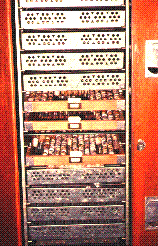 Quail eggs can be incubated successfully in any standard size commercial incubators. However, trays must be modified by adding 1.3 cm x 2.5 cm strips of welded wire to the chicken egg tray holders. Special wooden tray can be ordered to suit the size of quail eggs. Be sure to orient the eggs large end up in the setting trays or place flat in a horizontal tray. Quail eggs will hatch successfully if they are placed in an incubator in any position except with the large end down. The incubator should have a fan to provide adequate air circulation because the developing embryos use oxygen and give off carbon dioxide and heat. Little ventilation is needed at the beginning but the requirement increases as incubation progresses. The machine should be equipped to allow automatic turning of all eggs through an angle of 90 at least 4-6 times per 24 hours. Turning regularly is particularly critical in early incubation to prevent the embryos from adhering to the shell membrane. Lack of turning during the first 3 to 4 days will produce some malformed embryos as well as other minor defects. Turning may be discontinued after 14 days.
Quail eggs can be incubated successfully in any standard size commercial incubators. However, trays must be modified by adding 1.3 cm x 2.5 cm strips of welded wire to the chicken egg tray holders. Special wooden tray can be ordered to suit the size of quail eggs. Be sure to orient the eggs large end up in the setting trays or place flat in a horizontal tray. Quail eggs will hatch successfully if they are placed in an incubator in any position except with the large end down. The incubator should have a fan to provide adequate air circulation because the developing embryos use oxygen and give off carbon dioxide and heat. Little ventilation is needed at the beginning but the requirement increases as incubation progresses. The machine should be equipped to allow automatic turning of all eggs through an angle of 90 at least 4-6 times per 24 hours. Turning regularly is particularly critical in early incubation to prevent the embryos from adhering to the shell membrane. Lack of turning during the first 3 to 4 days will produce some malformed embryos as well as other minor defects. Turning may be discontinued after 14 days.
Fan-ventila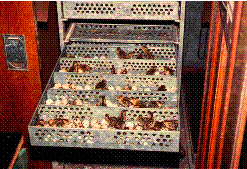 tion incubators should be set at 37.5 + 0.3 ºC. If the temperature of the incubator exceeds these recommendations many embryos may die. During the hatching period temperature should be lowered 0.5 ºC. A relative humidity of about 60 percent is satisfactory during incubation and should be raised to about 70 percent during the hatching period. The incubation period is 16 1/2 to 17 1/2 days. The duration of incubation may range from 16 to 18 days depending upon temperature, humidity and genetic variability. Some farmers in Singapore transfer the developing eggs to a separate hatcher on 15th day of incubation. It takes 10 hours from pipping to hatch, and an additional 5 hours for drying the chick. Then the quail chicks are ready to be distributed to other farmers or go into the brooder for rearing.
tion incubators should be set at 37.5 + 0.3 ºC. If the temperature of the incubator exceeds these recommendations many embryos may die. During the hatching period temperature should be lowered 0.5 ºC. A relative humidity of about 60 percent is satisfactory during incubation and should be raised to about 70 percent during the hatching period. The incubation period is 16 1/2 to 17 1/2 days. The duration of incubation may range from 16 to 18 days depending upon temperature, humidity and genetic variability. Some farmers in Singapore transfer the developing eggs to a separate hatcher on 15th day of incubation. It takes 10 hours from pipping to hatch, and an additional 5 hours for drying the chick. Then the quail chicks are ready to be distributed to other farmers or go into the brooder for rearing.
Brooding Facilities:
Quail chicks can be brooded successfully in several types of commercial or game-bird battery brooders. When commercial chick battery brooders are used they must be modified to suit the small size of quail. The openings in the wire floor should be covered with a rough-surfaced paper during the first week to avoid damage to feet and legs. The wire sides of the brooder must be closed with either fine mesh or paper to prevent escape of the baby quails.
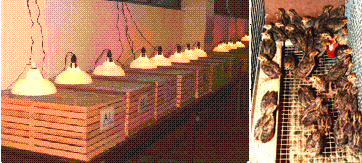
Heat:
Young coturnix chicks need extra heat to keep them warm until they are feathered. The proper brooding temperature for young birds is very important for successful management. The newly hatched quail chicks are transferred directly to the brooder from t he incubator. The heat to start with in the brooder should be only slightly lower than that of the incubator. They require a high temperature (37 ºC) at first and the temperature can be reduced 3 ºC each week until room temperature (28 ºC) is reached. Any brooder should afford an escape from under the heated area so the chicks can go and come as they wish. Feed and water are usually placed outside the heated hovering area. Thus, the chicks are forced to venture out from under the heat. This gives them needed exercise and accustoms them to lower temperature.
Feed:
Flat paper plates can be used as feeders for the first few days. Later, a 10 cm x 30 cm x 3 cm galvanized floor feeder with a 1.2 cm x 1.2 cm welded wire grill is placed over the opening to prevent feed wastage.
Water:
Water should be provided at all times. Care must be taken with small quails to prevent drowning in water troughs for the first two weeks. A pint canning jar with a glass or plastic fountain base works well. It should be modified by placing a donut shape d piece of hardware grill in the trough at the base. A shallow dish or pan filled with pebbles or marbles will also work. The chicks can drink between the marbles, but can not fall into the water. When chicks reach one week of age, the pebbles or wire protection can be removed with safety. It is important to provide clean water at all times. The water containers or troughs should be cleaned daily.
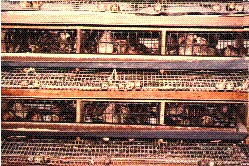 The system of housing depends very much on the type and scale of the quail enterprise. Most commercial quail farmers in Singapore will use a cage system. They build their cages inside closed houses with wire mesh surrounding both sides of the house for well ventilation. A concrete floor is essential, and the building needs to be substantial enough, not only to deter rodents and other pests but also to provide drought-free and well-ventilated, sheltered accommodation. Canvas-cloth is sometime hanged over on both sides of the house is prevent direct sunlight into the cages. The quails are never exposed to direct sunlight.
The system of housing depends very much on the type and scale of the quail enterprise. Most commercial quail farmers in Singapore will use a cage system. They build their cages inside closed houses with wire mesh surrounding both sides of the house for well ventilation. A concrete floor is essential, and the building needs to be substantial enough, not only to deter rodents and other pests but also to provide drought-free and well-ventilated, sheltered accommodation. Canvas-cloth is sometime hanged over on both sides of the house is prevent direct sunlight into the cages. The quails are never exposed to direct sunlight.
The farmers use 6 tier high cages which indicates how little head room this quail requires. Each unit is about 6 feet in length and 1 foot in width, and subdivided into 6 subunits. The farmers use very little metal in their cages. The birds stand on sloping slatted wooden floors. The droppings fall into pull-out wooden trays. Front and rear of cages are closed by wooden slats. Long narrow feed troughs are placed in front of the cages and PPC water troughs are placed at the back of the cages. The eggs roll out under the feed troughs and are collected twice daily, once in the morning and once in the evening. Commercial egg layers are usually housed in colonies of 10-12 birds per cage. For breeding purposes, male quails are introduced in the cages i n the ratio of 1 to 3 females.
Lighting For Laying Quail
From experiment it has been proved that light has more importance than temperature in stimulating hens to lay. One report indicates the bird will lay to zero temperature if the light of day is extended to at least 14 hours.
A bright light is not necessary. Just enough to maintain wakefulness and social activity in the flock is sufficient. Electric bulbs of 40 or 60 watts may be used in colony pens.
For the light to be effective it must be turned on before dark and calculated to go off after the day has been extended to 14 or 16 hours. Control of the light may be by a time switch. Singapore quail farmers always leave the light on continuously during the night, and there is indication that hens may lay just as well if the light is left on all the time.
The nutrients that comprise a quail diet are water, protein, carbohydrate, fat, minerals, and vitamins. Although all are essential, adequate water may be considered the single most important nutrient. Fresh clean water should be provided continuously to all birds, especially under the tropical environment. Quails require at least twice, as much in weight of water as they require in weight of dry feed . They may require more water if there are excess salts in the feed or during ho t dry season.
Protein.
Protein provides the amino acids for tissue growth and egg production. The dietary protein requirement of quail is influenced by metabolizable energy content and the ingredients used to formulate the diets. The earlier investigators raised their quail f locks successfully on turkey starter diets containing about 25-28% crude protein have shown that a dietary crude protein level of 24% is needed in starter diet for quail and t he protein content may be reduced to 20% by 3rd week of age.
Protein is the most expensive nutrient and must be provided from a high quality source. Protein quality is generally based on the amino acid composition of the feedstuff and the availability of these amino acids from the feedstuff through digestion in the gut of the quail. Amino acids are considered as the building blocks of proteins. Out of 19 total amino acids required by quail, 13 are considered as essential amino acids, because they cannot be produced in the quail’s body and must be supplied in the diet, and 6 are considered as nonessential, because they are synthesized by the body and need not be supplied in the diet. The 13 essential amino acids are: arginine, cystine, glycine, histidine, isoleucine, leucine, lysine, methionine, phenylalanine, th reonine, tryptophan, tyrosine and valine. Feedstuffs differ qualitatively and quantitatively in their amino acid composition. Quail diets consist mainly of plant materials. The most commonly used plant products are maize, soyabean meal, sorghum and rice or wheat bran. Methionine and lysine are generally low in plant products. Animal protein products such as fish meal, meat and bone meal etc., are good sources of most of the essential amino acids, but they are usually more expensive than plant protein ingredients. Synthetic methionine and lysine are usually added to the diets to balance the amino acid composition.
Energy.
The amount of food intake depends upon the metabolizable energy (ME) content of the diet, age of the birds, their reproductive status and the ambient temperatures. An energy requirement of 2,600 to 3,000 kcal ME/kg diet for growing quail has been reported from temperate regions whereas, findings under our tropic condition indicated an energy requirement of about 2,800 kcal ME/kg for growing quails and 2,550 kcal ME/kg for laying quails. Though raising the dietary energy levels from 2,600 to 2,800 kcal ME/kg did not influence the gain in weight, it affected significantly the efficiency of feed utilization as the feed consumption was reduced significantly.
The main energy source is provided by the grains and cereals which are the main ingredients in most feed. Fat such as animal tallow, lard or other vegetable oils are added to the diet if high energy is required by the quail.
Vitamins.
Vitamins may be categorized as fat soluble, (A, D, E, and K) and water soluble (the B-complex vitamins). Many vitamins are quite stable, but some deteriorate rapidly on exposure to heat, sunlight, or air. Housed quails are entirely dependent on the vitamins that are present in their compounded feed in the correct amount and proportions, for they have no access to the natural supply of these nutrients. The principal vitamin functions and requirements are as follows:
Vitamin A.
The principal feature of vitamin A is its function in ensuring adequate growth and as a means of assisting in the birds’ resistance to disease. Vitamin A is essential for normal vision, egg production, and reproduction. Laying quails receiving insufficient vitamin A produce fewer eggs and eggs produced frequently do not hatch. For egg production and fertility of females, a level of 2,500 I.U. vitamin A/kg diet was required. The hatchability and survival of newly-hatched c hicks were better with 3,200 I.U. vitamin A/kg diet.
True vitamin A exists only in animal kingdom. It may be formed by synthesis in the body of the bird from the precursor, carotene, which present in green vegetable matter or yellow corn. Because it increases exposure to air, grinding of feed materials will hasten the deterioration of this vitamin during storage, particularly if storage areas are warm or hot. As a result, the feed industry does not depend upon the bird’s receiving their vitamin A from ingredients in the diet. Dry or stabilized vitamin A is added to diet to meet the requirements of the bird. The supplementation of 4,000 I.U. vitamin A per kilo of diet for quails may be adequate for their optimum growth, production and reproductive traits.
Vitamin D.
This vitamin has several forms, but D2 and D3 are the most important. Vitamin D3 is utilized by birds, man, and four-footed animals, while vitamin D2 is of value to man and four-footed animals. Thus D3 becomes essential for quail. Vitamin D aids the absorption of calcium and phosphorus form the intestinal tract and the deposition of calcium on eggshell.
Yembroos® R & D experts observed that dietary deprivation of supplementary vitamin D3 did not affect body weight of male and female Japanese quail despite a reduction in feed intake. However, the production of eggs was reduced from 74% to 20%. In another experiment, the mature male quail remained in good physical condition on practical diets devoid of vitamin D3 for 1 year. But a mortality of about 90% was observed in females and 16% in males even when both were in negative calcium balance of about the same order.
Vitamin D is associated with sunlight, for sunlight provides irradiation that stimulates the manufacture of vitamin D in the skin of the bird. Unfortunately, laying quails are seldom exposed to direct sunlight, so the body synthesis of vitamin D is limit ed. The quail producer normally adds vitamin D to the quail diet in required amount to meet productive objectives rather than relying on synthesis or feed ingredients.
Vitamin E.
A deficiency of vitamin E causes a disease of the nervous system in chicks known as ‘crazy chick disease’ (encephalomalacia). It is also essential to breeding stock for the good hatchability of their eggs. Encephalomalacia occurs when the diet contains unsaturated fats that are susceptible to rancidity. Several antioxidant compounds, in addition to vitamin E, are usually added to prevent the fat from going bad.
A deficiency of vitamin E in semi-purified diets containing isolated soybean protein and starch did no t affect the body weight, feed consumption, or egg production of Japanese quail. However, it caused sterility in males, which was overcome by restoring 40 I.U. vitamin E/kg to the diet for about 2 weeks. The fertility and hatchability of quail eggs were severely depressed after the birds were fed a conventional diet containing glucose and soybean meal, but deficient in vitamin E for 20 weeks. No encephalomalacia or muscular dystrophy were observed in quail fed vitamin E deficient diets for 35 weeks.
Whole grains and alfalfa meal are the best natural sources of vitamin E. Synthetic tocopherols (vitamin E) are available, and these are usually added to quail starter and breeder rations.
Vitamin K.
Vitamin K is an essential element in the synthesis of prothrombin, a chemical necessary for blood clotting. A deficiency can lead to the rupture of blood vessels and causing excessive bleeding. It is present naturally in all green foods, especially rich in lucerne meal. The needs are small, and 2 i.u./kg will suffice under normal conditions. A synthetic, water-soluble form of vitamin K3 is generally added in the diet.
Vitamin B complex.
The B vitamins are well distributed in cereals and grains, and deficiencies are normally unlikely to occur. The main functions of the B vitamins are to assist the quail in achieving its optimum growth.
Thiamin (vitamin B1) is needed for the metabolism of carbohydrates, which reported classical symptoms of polyneuritis in newly hatched quail chicks from a flock fed turkey breeder diet calculated to contain 3.2 mg thiamin/kg. These quail responded positively to thiamin injection. Breeding Japanese quail may have a higher requirement for thiamin than breeding fowls which is reported to be 0.8 mg thiamin/kg diet.
Riboflavin (vitamin B2). suggested a minimum requirement of 8 mg riboflavin/kg diet in absence of vitamin B12 and vitamin C, but it decreased to 4 mg per kg in presence of these vitamins. The characteristic symptoms of riboflavin deficiency were slow growth, high mortality, impaired gait and posture which is known as ‘curled toe paralysis’ in quails. Feathering was absent other than down at the end of two weeks of riboflavin deficiency.
The 4 and 8 mg/kg of riboflavin were sufficient to maintain normal egg product ion. Data obtained in weekly hatches showed that the addition of small quantities of riboflavin supplement to the basal ration increased the incidence of curled-toe paralysis whereas larger amounts decreased it.
Nicotinic acid. The age of the birds determines the severity of symptoms of nicotinic acid deficiency. A marked depression in growth, closure of eyes, reduced activity and a marked atrophy of the pectoral muscle were observed in quail on nicotinic acid deficient diets.
Pantothenic acid. A supplementary level of 7.5 mg calcium pantothenate/kg diet was needed in purified diets for prevention of mortality and for normal growth of quail chicks, but 10-30 mg was needed for normal feathering..
Breeding quail needed 15 mg supplementary calcium pantothenate per kg diet for optimal fertility and hatchability. Eggs from pantothenic acid deficient hens were characterized by embryonic mortality late in incubation period, haemmorhagic embryos, oedema and embryos with crooked legs.
Choline. Growing Japanese quail required higher levels of dietary choline to support maximum growth, prevent perosis, maintain maximum egg weight, egg production and hatchability than chickens. Mature quail differ from laying fowls as they require performed choline. The suggested requirement of quail for egg laying is about 3,100 mg/kg diet.
Folic acid. Folic acid deficiency in growing quail caused poor feathering, high mortality, leg weakness and cervical paralysis. These symptoms were similar to those observed in turkey poults. Quail chicks also suffered from a mild anaemia , and a curled toe syndrome. The folic acid requirement of growing quail was between 0.3 to 0.36 mg/kg casein-gelatin based diet.
Biotin. the need of supplementary biotin for gain in body weight of quail and for increase in egg production.
Vitamin B12 (Cobalamin). vitamin B12 is required for the development of normal red blood cells. For better hatchability, sufficient pantothenic acid and vitamin B12 are also essential.
Substantial quantities of vitamin B complex are found in all the ingredients in feed. It should be stressed that vitamin B12 is found only in foods of animal origin.
Gambel’s Quail (Callipepla gambelii)
The Gambel’s Quail is a well known species in aviculture and in the wild. Also known as the Arizona, top-knot or desert quail, they are found in arid areas of the southwestern United States and parts of Mexico. Gambel’s Quail have also been successfully introduced to Lanai and Hawaii in the Hawaiian Archipelago. Paul Johnsgard describes seven subspecies, all of which are similar and I don’t believe that the subspecies are differentiated in captive populations.
This species is often confused with the related Valley Quail. Males of both species share the black top-knot plume. Male Gambel’s can be distinguished by having no scaling on the lower breast, but rather having a yellowish belly with a large black spot. The top of the head is rusty brown with a white border and a black face, forehead and chin; the back and upper breast is grayish brown with rusty brown flanks that have white streaks. Females also have a top-knot, but it is much smaller in size. Her overall coloration is similar to the male, but she lacks the black and white face, the black breast spot and the rust color on her is much lighter. The hen is also slightly smaller than the male.
In the wild, Gambel’s Quail form large groups or coveys. Dr. Leland Hayes reported flocks as large as 200 during the winter in Arizona! During the spring, these large flocks break up and the males begin to draw females to their chosen territory. Fights between rival males can become quite vicious while they try to draw mates into their territories.
Breeding
This species is a prolific layer in captivity and clutch sizes are quite large. Here in Missouri, I noticed that do not start laying until mid-May, but I’m sure it is much earlier in warmer climates. In the wild, the female does the incubating which lasts about 23 days. The male often stands close-by and helps with the brooding. I’ve yet to have a Gambel hen go broody in captivity, but they hatch well and the tiny chicks are easy to raise. They do grow fast, flying at about three weeks of age!
General Comments
This species is real joy to have in your aviary and the male’s call reminds one of the old-west movies! They are very active and nervous, therefore require a larger pen than most quail. We keep our Gambel’s on wire, but they do well on the ground in well drained pens. Our cages include many branches for perching and a pan of sand for a dust bath. We provide limbs of pine needles that the hens nest under.
Gambel’s can be quite aggressive when adding new birds to an existing flock during the breeding season. If you must add a new bird, do so during the winter when they form coveys. It is also a good idea to keep many birds together during the cold months, this way they will naturally form a covey for warmth.
As a treat, we regularly provide our quail with spray millet and mealworms.
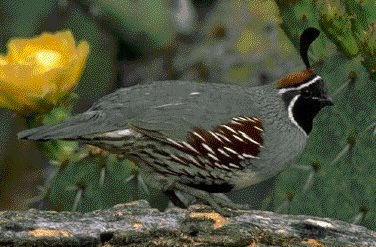
One of the most sought after quail in North America is the Mearns quail. It sometimes is confused with another popular quail also sometimes called the Harlequin. The African Harlequin is not the Mearns Harlequin. The African Harlequin comes from South Africa while the Mearns comes from the southern United States and Mexico.
The confusing factor is that the Mearns has many names. It is called the Harlequin quail, Black quail, Cincoreal quail, Codorniz Encinara, Codorniz Pinta, crazy quail, Mearns quail, painted quail and many more.
Mearns are the most unusual of the New World quail. They look like a committee put them together, as they are out of proportion when compared to any other quail. Their heads are extra large, and their eyes are big and compelling when they give you their famous ‘melt your heart stare’.
Raising chicks: Most people have too much humidity in their incubators when hatching Mearns quail. If your hydrometer wet bulb is around 82 degrees F. this will allow the chicks to remain smaller and seem to be stronger when they hatch. Mearns chicks do not know to eat by instinct. They must be taught. In the wild, the parents catch and feed insects to the chicks from their beaks. Several methods have been used successfully to get the chicks to eat under captive conditions. The most popular is to fed small mealworms from tweezers to the chicks. (Never just throw mealworms into the pen for the chicks to pick up as the will begin to pick toes.) They soon learn that the mealworms tastes pretty good and will get on your hand for their food. Try anything that you can think of to convince them to eat or else they will die.
Probably one of the most striking of all the members of the quail family is the Mountain Quail. It is by far the largest and has some of the most desirable characteristics of any quail kept in captivity. The Mountain quail is also known as Codorniz de mountana, Mountain partridge, Painted quail, Plumed quail, and San Pedro quail.
An interesting thing about Mountain quail is the way the eggs hatch. Eggs often hatch over a three day period which is unusual for any member of the quail family. Usually these birds pop right out of the egg. Another thing about Mountain quail is their reputation for not being regular producers. This is certainly true in the wild and most breeders have found they have an “off year” with these birds.
Adults , 10.6-11.5 inches long. The sexes are very similar in appearance. This relatively large western quail differs from all others in that both sexes have straight, narrow, and blackish crests composed of only two feathers, which appear with the juvenile plumage. The throat is chestnut, edged with black, and this is separated from the slate gray on the back, wings, and tail.
The Blue Scale is about 10 1/2 inches long at maturity. The sexes are almost identical in plumage color. Their name come from the delicate scale markings in their plumage which varies from slate blue to grayish in color. Both sexes have the cotton topped crest. Males can be detected from females by the plain brownish chin coloration. The females will have light pin stripes in the chin area.
Raising Blue Scale Quail: Some people dislike this quail because of their nervous disposition. They are like the Gambel and the California Valley quail because they are an active, nervous, and somewhat timid bird. Although they are suspicious, people have found they can be tamed down and will come over to the fence for a treat of mixed grain.
Generally, Blue Scale quail are very good layers. The eggs are larger than Bobwhite and are not so pointed on the little end. The eggs hatch best in a dry incubator.
The key to raising Blues is a large pen if you can put them on the ground. Blues can be raised on wire, but if you climate is dry and your soil is light, I would recommend they be put on the ground at least during the breeding season. A good size pen would be 20 feet long by 8 feet long.
More Information:
Blue Scale Quail, Callipepla squamata, inhabits northern and central Mexico, Arizona, New Mexico, western Texas, and the southwestern portion of Kansas. At maturity, Blue Scale measure about ten to eleven inches in length. The overall plumage color for both sexes is the same – light blue-gray. Their name refers to the black scale-like markings in the feathers on the neck, back and under-parts. Both sexes have a white-tipped or cotton-top crest. To sex Blue Scale, look at their chin feathers. Males will have plain light brown feathers and females will have faint brown pin-stripe in the chin area. The head of the male will be more massive in appearance. Females will also be smaller in size and usually, the crest will be sparse looking compared to the male’s crest. The Chestnut-bellied Blue Scale, Callipepla castanogastris, is a popular subspecies found in captivity. Their coloration is similar to that of the Blue Scale, but there is a large conspicuous chestnut-brown patch on the lower breast. Sometimes, in older Chestnut-bellied cocks, the blue-gray is a little darker than the color of the Blue Scale.
Blue Scale are usually non-aggressive and can be run with other quail species during the non-breeding season. Unless the area in which the birds are kept is dry and the soil is sandy and dry, the best way to raise Blue Scale is to put them on wire with one pair or a trio to a pen. Because they are more nervous or flighty than Bobwhite Quail, they require a larger pen that is longer than it is wide. This allows the birds to exercise and to be out of your way when you feed and water them. The pen should have an area where they can hide or feel secure. One end of the pen can be boxed in with an opening for the birds to enter this area and a lift-up lid so eggs can be gathered. A nest box can also be placed in this area. In our area depending on how cold and damp spring has been, Blue Scale hens usually start laying in mid-May.
Blue Scale hens are good layer’s and it is not uncommon for a hen to lay 50-60 eggs a year. The eggs, which have irregular light to dark brown spots, are larger in size and less pointed than those laid by Bobwhite hens. Eggs are collected daily and stored small end down on quail flats until they are set. They are set once a week in a GQF 1402 incubator with an electronic thermostat. The temperature is set at 99.5 degrees F. During incubation we try to maintain the humidity at 83 degrees F. web bulb. Incubation takes 23 days.
After the chicks hatch, I start them out in plastic brooders that we make from 42 quart plastic storage boxes that have a lid. At one end of the lid, we cut out a section and replace it with wire which is hog-ringed in place. A layer of newspapers is placed in the bottom of the box, this is toped with either “Easy Liner” or rough paper towel which is changed every day. Since the chicks are started in the house, a 40 Watt light bulb provides additional warmth. Blair Super Start chick mash is sprinkled on the toweling the first day and chicks have no difficulty starting to eat. Later their feed is placed in small feeders. Chicks are kept on Super Start until they are moved to large floor pens in the barn. For the first 5 days, I add LS-50 to the drinking water. After the medication cycle in completed, I add GQF Vitamins Plus which contains a live bacteria to the drinking water for several days. Then about two times a week throughout their growing period, I add Chick Pak to their drinking water. To keep the chicks from getting wet, I use drown-proof water bases. The chicks are given fresh water daily in clean, sanitized waterers.
When the chicks are about a week old, they are moved to the brooder house and placed in larger brooders constructed of wood and hardware cloth. From these brooders, they go to larger wire pens the brooder house. I can use a light bulb for additional warmth if needed. When the birds are almost totally feathered out, we move them to the larger floor pens without supplemental heat in the barn. They remain there until they are paired up for breeding or sold. From the time the birds are taken to the brooder house, I use preventative dosage of BMD (Bacitracin) in the drinking water about every two or three weeks to prevent Quail Enteritis.
Despite the fact that we are around our Blue Scale Quail everyday, they have not tamed down and remain very active. Unlike some chicks and adult gamebirds that will eat grain or treats from a person’s hand, I have not found this to be true for our quail. In spite of this, I still enjoy having Blue Scale Quail and hearing their call through out the day.
Of all the birds native to the sate of California, none is more universally enjoyed and appreciated than the California Valley Quail. The handsome plumage, pert demeanor, and melodious calls are appealing to everyone fortunate enough to know the species, and is it is not surprising that in 1931 the State Legislature by unanimous acclamation declared the California quail to be the State Bird of California. This attractive bird is known by many names, including, California partridge, Catalina quail, Topknot quail and Valley Quail. It is known commonly in California as the Valley quail, to distinguish it from the Mountain quail; but ornithologists now recognize two subspecies, the California quail and the Valley quail, both entirely distinct from the Mountain quail.
The range of this quail is made up of varied topography and climatical conditions. It is found from Baja California, Mexico, up through the western states into Canada. Its eastward range goes as for as Nevada, Utah and Idaho with introductions in Colorado.
In captivity, the California quail is one of the easier quail to get to breed. They are by nature very nervous and thus do not do as well in small cages as some of the other quail. It is believed they do much better on the ground if you have a drier climate or if you make dry ground available for them. Many are raised on wire every year so there is no hard rule about them.
There are two subspecies of this species. The most commonly one seen in captivity is the Chinese (B. t. thoracica), which is native to China and has been to introduced into southern Japan and on Maui in the Hawaiian Islands. The other subspecies, (B. t. sonorivox), is found only on Taiwan.
The sexes of this species are similar, with the female being slightly smaller. They have a bright rufous throat and face; gray above the eye and extending to the base of the neck. The breast and back is mottled with black, buff and chestnut. The Chinese subspecies is much lighter than the subspecies from Taiwan.
Breeding
The breeding season begins in the late spring, when the hen lays her clutch of 7 to 9 eggs. You will probably have to incubate in an incubator or under very small foster hens. The incubation lasts about 18 days.
The chicks are tricky to raise. In the wild, the hen will offer food to the little chicks from her beak, so in captivity, they have a hard time to learn to eat on their own. You will have to encourage them to start eating with the help of a teacher, usually a similar sized chick, or you can use mealworms and offer them with your fingers. Watch the birds carefully and make sure they are getting enough.
General Comments
The Chinese Bamboo Partridge is smaller and more delicate than most other partridge species kept in captivity. They are tropical and need protection from freezing weather. Although attractive and well established, this species is not recommended for the beginner.
As far as I know, this species of Bamboo Partridge is not kept in captivity. There are two subspecies in the wild, (B. f. fytchii) found in eastern China and Vietnam and (B. f. hopkinsoni) from south-western China, India and burma. They are considered rare in their natural range.
Both sexes resemble the Chinese, but have a yellowish throat instead of rufous and have a blackish eye stripe.
Breeding
In the wild, the breeding season begins in April and 3 to 7 eggs are laid. Incubation is believed to be 18 days.
General Comments
Since this species is rapidly declining in their native lands, a captive breeding program needs to be established.
One of the most attractive members of the Rock Partridges, genus Alectoris. Barbary Partridge are very popular with aviculturists and do well in captivity. In the wild, there are about six subspecies that range from Morocco across North Africa into Libya and Egypt. There are very slight, if any, differences in each of the subspecies. They have introduced into the Canary islands and unsuccessfully on the main island of Hawaii.
While they similar in size and general appearance to other species of the genus, Barbary Partridge are much more colorful upon closer observation. The face is light gray, surrounded by a chestnut band that is flecked with white. The breast is more buff than other Alectoris species, while the shoulders and back are the same bluish-gray. The sexes are alike, with male being slightly larger and may have small spurs on the red legs.
Breeding
I have found that this species does best when kept pairs, as one will become very dominant over the other. The hen begins to lay her clutch of between 8 and 15 eggs in April. Some hens have been reported to lay as many as 30 eggs per season! Some breeders are experiencing a great deal of infertile eggs however, due in large part to inbreeding.
Incubation lasts 24 days and he chicks are similar to the Chukar and Red-legged Partridge chicks in that they are easy to care for.
General Comments
Barbary Partridge are quite popular in captivity. Most breeders keep them on wire like other species of partridge. They are not as hardy as Chukars and Red-legs during the Winter. It is best to group as many together for warmth. Please don’t make the mistake I did one year. I once put them together a little too early, end of September, and I had a male that proceeded to attack and injure the other males! They do not need any heat, but do protect them any drafts and direct winds.
As mentioned, inbreeding has become a problem. New bloodlines are needed to keep the captive populations viable.
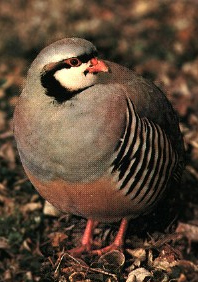 One of the most commonly kept and bred of all game birds, there are some game bird farms in North America that produce thousands of Chukars each year for hunting reserves and release. Chukars are also known as great birds for the beginner in the hobby, being very easy to keep and breed in captivity.
One of the most commonly kept and bred of all game birds, there are some game bird farms in North America that produce thousands of Chukars each year for hunting reserves and release. Chukars are also known as great birds for the beginner in the hobby, being very easy to keep and breed in captivity.
There are fourteen recognized subspecies that range from Turkey, the Mediterranean islands, Iran and east through Russia and China and south into Pakistan and Nepal. The Chukar has also been successfully introduced into western North America, the Hawaiian Islands, England and New Zealand.
Chukars resemble other members of the genus Alectoris, being mostly gray all over with a black band from the eyes, down to below the neck. They also have several black bars on the flanks. The sexes are similar, with the female having a smaller knob on the legs than the males. Males also appear to be somewhat larger as well. Both sexes share the bright red bill and legs. Chukars have been known to hybridize with other members of the genus.
Breeding
Chukars are very versatile breeders in captivity. They can be kept in pairs, trios and even in large colonies. Best fertility is with the smaller groups. Hens begin to lay in April and may lay well into the Summer. Hens may lay a large number of eggs in a season. 40 to 50 eggs per hen is not unusual. Chukars, as a rule, will not usually sit on their own eggs, so you will need to gather the eggs and place them in an incubator. Small bantams may be used, but choose only the smallest hens to set. Incubation lasts about 23 days.
Chicks are easy to raise. They are very active and require lots of room in the brooder. They are prone to cannibalism, so don’t overcrowd in the brooder. They grow quickly and can be placed outside at about 6 weeks of age.
General Comments
 As I have already mentioned, Chukars are great birds for beginners as they are so easy to keep and breed. Like most other partridges, Chukars do best when kept in wire-bottom pens. If kept on the ground, they are very susceptible to a number of worms, as well as the disease blackhead. You can keep the birds on the ground if the aviary is well drained and there is no standing water. Chukars are native to dry, rocky areas in the wild, so landscape the aviary accordingly. It is also wise to worm the birds monthly as well. When kept on wire, Chukars are separated from the organisms in the soil. You can place a pan of sand for the birds to “dust” themselves in.
As I have already mentioned, Chukars are great birds for beginners as they are so easy to keep and breed. Like most other partridges, Chukars do best when kept in wire-bottom pens. If kept on the ground, they are very susceptible to a number of worms, as well as the disease blackhead. You can keep the birds on the ground if the aviary is well drained and there is no standing water. Chukars are native to dry, rocky areas in the wild, so landscape the aviary accordingly. It is also wise to worm the birds monthly as well. When kept on wire, Chukars are separated from the organisms in the soil. You can place a pan of sand for the birds to “dust” themselves in.
Chukars are very hardy and can withstand both extremes of temperatures. During the Winter, keep as many birds as you can together so they can covey for warmth.
Mutations
There are several color mutations established in captivity including buff, red and white. I am not sure about the origins of these mutations, but will post here if the information becomes available. The photo to the right is of the red mutation. As you can see, the overall color is light red. The black band that is seen in the normal Chukar is now dark red as are the streaks on the flanks.
Hungarian Partridge (Perdix perdix)
Fast Facts
Other Names: Gray Partridge, Hun, English Partridge, Bohemian Partridge, European Partridge.
Range: Great Britain, Northern Spain, France and Italy east through Europe into Turkey, Russia and western Siberia. Introduced throughout the world and well established in the United States.
Subspecies: There are seven subspecies according to Robbins. P. p. perdix, P. p. hispaniensis, P. p. armoricana, P. p. sphagnetorum, P. p. lucida, P. p. canescens and P. p. robusta.
Habitat: Prefers open areas, farmlands and brush.
Description: The face and throat is rusty-orange. The breast is finely vermiculated gray with a dark-chestnut horseshoe marking on the upper abdomen; the belly is white and to light buff. The upper back is vermiculated brown, gray and white; the wings are mottled with dark brown. The tail is chestnut.
Description, Female: The hen is similar to the male. The horeshoe marking on the breast maybe absent, smaller or lighter than in the male.
Status in Wild: Common in both the original range and in the US.
Status in Aviculture: Very common and often kept by small breeders and large scale game farms.
Breeding Season: Begins in late April and may last into September.
Breeding Age: First year.
Clutch Size: 15, hens will lay several clutches per season.
Incubation Period: 24 days.
Misc. Aviculture Notes: While they will get along in groups during the winter months, birds must be paired up by early March or fighting will begin. Can be kept on the ground or on wire. Pen sizes should be at least six feet long by two feet wide. If on wire, a portion of the cage should have a solid bottom with sand or straw for the hen to nest in. They are hardy birds and able to withstand temperature extremes.
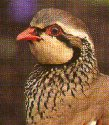 The Red-legged Partridge is very similar to the Chukar. Although common in captivity, it is not bred on the large, commerical scale as it’s close cousin. There are four subspecies in the wild. The French Red-leg (A. r. rufa) of France and Italy, is the subspecies most often seen in captivity (it also the bird pictured to the right). The Spanish Red-leg (A. r. hispanica), is found in northern and western Spain is also kept, but not as common as the French subspecies. There is another subspecies that is resident in eastern and southern Spain, the Southern Spanish Red-leg (A. r. intercedens); the last subspecies is native to Corsica, the Corsican Red-leg (A. r. corsa). There is only slight differences in the subspecies, and the Corsican is almost indistinguishable from the French. This species has been introduced into many places worldwide, including the Canary Islands, the Azores, England and some parts of North America.
The Red-legged Partridge is very similar to the Chukar. Although common in captivity, it is not bred on the large, commerical scale as it’s close cousin. There are four subspecies in the wild. The French Red-leg (A. r. rufa) of France and Italy, is the subspecies most often seen in captivity (it also the bird pictured to the right). The Spanish Red-leg (A. r. hispanica), is found in northern and western Spain is also kept, but not as common as the French subspecies. There is another subspecies that is resident in eastern and southern Spain, the Southern Spanish Red-leg (A. r. intercedens); the last subspecies is native to Corsica, the Corsican Red-leg (A. r. corsa). There is only slight differences in the subspecies, and the Corsican is almost indistinguishable from the French. This species has been introduced into many places worldwide, including the Canary Islands, the Azores, England and some parts of North America.
The colors of both sexes are similar to other members of the genus, but has a white forehead and a broken black line on the neck and throat which distinguishes them from the other species. The flanks are also more barred with brown and buff, mixed with white. The males have small spurs and are slightly larger than the females.
Breeding
The breeding season begins in late April and early May. Like the chukar, Red-legs are unlikely to set and hatch their own eggs. Incubation lasts about 23 days and the young should be treated in the same matter as the Chukar. They do not lay the large number of eggs as a Chukar hen, clutches are only about 10 to 12 per bird.
General Comments
Red-legged Partridge do best when raised on wire. They are prone to a number diseases transmitted by wet soil, including Blackhead which is very common in partridge. If the birds are infected with Blackhead, you can use the drug Emtryl as treatment.
This species is hardy and easy to keep in captivity. Some feel that they are a better game bird than the chukar, since they prefer a more grassland like habitat. Some game bird preserves have crossed them with Chukars for release.
The Roul-roul Partridge is also known as the Crested Wood Partridge, Green Wood Partridge or Red-crowned Wood Partridge. They are native to the tropical rain forests of Burma and Thailand, south to Malaysia, Borneo and Sumatra and despite not often kept in captivity, they are charming aviary birds. The Roul-roul Partridge is the sole member of the Genus Rollulus and has no known subspecies.
Unlike the Rock Partridges, Genus Alectoris, the sexes are different. The male, seen in the front in the photograph, has a large red crest, red orbital skin, overall glossy bluish-purple body and red feet and bill. The hen is much drabber in comparison. She lacks the bright crest, has an overall greenish color with chestnut-brown wings, black bill and red feet.
Breeding
If kept in an indoor, tropical environment, Roul-roul may lay at anytime during the year. The males seem to do most of the nest building, using pine needles, branches or straw to create a tunnel like nest. Clutches range from about 4 to 6 eggs. Incubation is done by the female and lasts 18 to 22 days.
In captivity, the chicks of this species may have problems learning to eat. Provide mealworms and place a few small size chicks such as button quail in the brooder to help “teach” the little partridge to eat.
General Comments
Roul-roul are not often kept and bred in aviaries and remain somewhat expensive. They are not recommended for the beginning breeder and are still a challenge for even experienced breeders. They are prone to develop many poultry diseases, and need to be kept away from ground where other game birds have been kept. They also do not seem to do well on wire, often developing foot and leg problems. It is recommended that they are kept in pairs in aviaries with sand bottoms and well planted.
Roul-roul are not very winter hardy and need heated quarters during extremely cold weather.
Pheasants are among the world’s most beautiful birds. All but one of the approximately 49 species, and many more subspecies, of pheasants are native to Asia. They inhabit a variety of habitats, from the snowy Himalayas to the steamy jungles of Indonesia.
Pheasants have long been avicultural subjects. Egyptian pharaohs kept peafowl and Alexander the Great brought them to Greece some 2,500 years ago. It is reported that George Washington even kept Golden Pheasants at Mount Vernon. Their adaptability to aviculture is important in their survival. One species, the Edward’s Pheasant, was once believed to be extinct in the jungles of Vietnam, but there were sustainable populations in aviaries and re-introduction programs are now in place. The Cheer Pheasant from Pakistan and Swinhoe’s Pheasant from Taiwan are two species who have benefited from re-introductions of captive-bred birds. However, pheasants have also been one of the most mismanaged family of birds in captivity and the need for profit in American aviculture has lead to a number of hybrids, inbreeding issues, mutations and complete disappearances of species and subspecies. While mass production has been promoted in America for years, we must now realize that this is not an effective conservation tool and we need to establish a conservation breeding approach or we will lose these species.
This section is an introduction to the pheasants of the world and their captive management. Each species is described with natural history information, avicultural data, images, and web links. It is my hope that with this site people will become aware of the plight of these wonderful birds. It is highly recommended for the visitor to advance their knowledge by using the references and further readings recommended on the species sheets. These sheets are only an introduction and if a person is interested in pheasant aviculture, please read all available material and books before purchasing your birds.
Range: The Himalayas, from Nepal through Tibet into northern Burma to northwest China.
Subspecies: There are eleven subspecies according to Johnsgard. The Himalayan Blood Pheasant (Ithaginis cruentus cruentus), Tibetan Blood Pheasant (I. c. tibetanus), Kuser’s Blood Pheasant (I. c. kuseri), Mrs. Vernay’s Blood Pheasant (I. c. marionae), Rock’s Blood Pheasant (I. c. rocki), Clarke’s Blood Pheasant (I. c. clarkei), Geoffroy’s Blood Pheasant (I. c. geoffroyi), Berezowski’s Blood Pheasant (I. c. berezowskii), Beick’s Blood Pheasant (I. c. beicki), Bianchi’s Blood Pheasant (I. c. michaelis), David’s Blood Pheasant (I. c. sinensis).
Habitat: High altitudes from 10,000 to 15,000 feet during the breeding season and down to 7,000 during winter. Prefers coniferous forests.
Brief Description: Quite unlike any other pheasant species is appearance, resembles partridge in both size and shape. The nominate race cruentus has a white crest, black line under and over the eye with red orbitial skin and throat. The upper breast is pale buff with red streaks, the lower breast and belly is light buff with marked the same as above but more pronounced. The rest of the body is streaked gray, white and buff. The tail is red also streaked with gray and buff. The main differences in the subspecies is the amount of red on breast and the markings on the face.
Brief Description, Female: The face, forehead and throat are light rust; the top of the head and the back of the neck are gray. The rest of the body is is overall light brown vermiculated with darker brown.
Status in Wild: Being native to such remote areas, this species has not been subject to the problems other pheasant species have due to man. While not much is known of its actual status in the wild, they remain unthreatened and stable. Status by BirdLife International/IUCN as Lower risk/least concern.
Status in Aviculture: I cannot find any sources in American aviaries or zoos. The latest records of this species was in the 1970s when Charles Sivelle had produced chicks. As far as I know (as of 12-2007, please e-mail me if you know otherwise), there are no Blood Pheasants in captivity in America. The species has been recently bred in Belgium by François Bernar.
Clutch Size: 5-12 eggs.
Incubation Period: 27-29 days.
Blood Pheasant (Ithaginis cruentus), 43 cm for male and 39cm for female. Crest grey, varying in length according to race; forehead, face, and throat red; breast streaked with red; above grey, the feathers prominently white streaked. Female: mainly brown to greyish brown.
Resident in Qinghai, Gansu, Shaanxi, Yunnan, Tibet, Shanxi, Henan and Sichuan. Inhabits rather high altitude, near snow line, or lower places in winter. In flocks of 4-20 in non-breeding season, up to 40 in winter. Descends from trees before daybreak to wood margins, gradually moving to and wandering in willow stands with lawns nearby or mixed forests of pine, fir and beech trees. Picks up food with its bill, seldom digs for food with claws but sometimes jumps up to shrubs to feed. Naps at noon and spends night at azalea twigs.
A good runner but poor flier. Rushes down hills, if at risk, and hides under stones. Scatters during breeding season and pairs in mid April. Between late April and early May, female builds a nest under paddy straw heaps surrounded by pine, fir and willow trees; in shrubs; under rocks; by fallen trees; or in tree holes near the ground. A shallow saucer nest of dry twigs lined with leaves; or of leaves, thin tree roots and mosses; piled up and then pressed and decorated with usnea outside; or of paddy straws and leaves, wormwood, pine needles, mosses and dry twigs lined with belly feathers. Eggs: 5-14, often 6-7; long oval, varying in size; pink or yellowish white with dark brown or rufous speckles; laid in May; incubated by female but guarded by male for 29-33 days; and covered with dry grass or feather when female is leaving. In a habit of moving the eggs or deserting the nest if at risk. Chicks seen in mid June, able to follow mother to feed at two days old. Lives in a covey till winter.
Other Names: Black-headed Tragopan, Western Horned Pheasant
Range: The western Himalayas in Northern Pakistan, Northwestern India
Subspecies: None
Habitat: Himalayan Forests
Status in Wild: Rare and vulnerable.
Avicultural Data
Status in Aviculture: They were first brought to captivity in the 1860s when over fifty birds were brought to the London Zoo and breeders in France over a thirty year period (Delacour 1977). They disappeared from collections in the 1930s and very few, if any, have been imported to Europe or America since. Currently, there are no Western Tragopans in captivity in the United States.
Misc. Aviculture Notes: A great deal of information will be gathered over the coming months as this species is currently being kept in captivity in the Himachal Pradesh India with the help of the World Pheasant Association.
Other Names: Indian Tragopan, Crimson Tragopan, Crimson-horned Pheasant.
Range: The central and eastern Himalayas.
Subspecies: None recognized.
Habitat: Mountainous forests from about 8,000 to 14,000 feet in summer and 6,000 feet in winter.
Description, Male: Head almost completely feathered and black, a band on each side of the crest, the sides of the neck, the upper back, shoulders, and upper breast, deep crimson red; rest of under parts crimson, with black and white ocelli, becoming larger and greyish on the abdomen and flanks; under tail coverts red, with brown-lined white ocelli, and two larger olive ones on the sides; longer tail-coverts brown with subterminal mottled dark brown and buff, the tip of tail black. Iris brown; bill black; bare skin of throat dark blue; lappet blue in the middle, pale green on the margins, with four or five triangular scarlet patches on each side; fleshy horns blue; the lappet extends to a length of 100 mm and the horns to 75 mm during display; legs pink. The tail is proportionally longer than other Tragopans. First year Male: Like the female, but larger and higher on the legs, with a black-head, much red on the neck and upper back, the breast more or less splashed with red, with few white ocelli.
Description, Female: Upper parts rufous to dull brown according to individual variation, with pale buff central markings and blackish vermiculations and patches; tail rufous brown with irregular black and buff bars; chin and throat pale brown or buff lined with black; under parts like the back but much lighter, particulary the abdomen where the pale center of the feathers expands into a large whitish spot. Iris brown; orbital skin bluish; bill horn brown; legs whitish grey.
Status in Wild: Listed as vulnerable, believed there are less than 20,000 remaining in the wild.
Breeding Season: April to June.
Breeding Age: Second year.
Clutch Size: 4-6.
Incubation Period: 28 days.
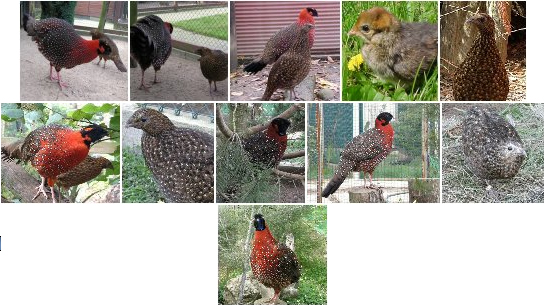
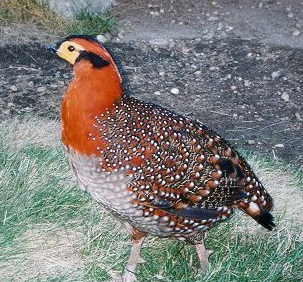 Other Names: Grey-bellied Tragopan.
Other Names: Grey-bellied Tragopan.
Range: Northeastern India, northwestern Myanmar and southern Tibet.
Subspecies: Two, T. b. blythi and T. b. molesworthi.
Habitat: Dense mountain forests to 9,000 feet.
Description: The largest of the Tragopans, the adult male is a brillantly colored bird. The bare face skin is bright yellow, a black band extends from the base of the bill to the crown and another black band extends behind the eye. During courtship, the yellow wattle is not as long as in other Tragopans, only about 1 1/2 inches long. The upper breast and neck is rusty red, not as bright as the Temminck’s or Satyr. The lower breast and belly is grayish-red with faint spots. The back and rest of the body is brownish red with many white ocelli. The full plumage is not attained until the second year. molesworthi is darker than blythi, gray on lower breast is paler and extends higher on the breast.
Description, Female: Similar to the Satyr hen, but is larger and paler. Overall dark brown with black, buff and white mottling. Differs from Temmincks in lacking the bold white spots on underparts. molesworthi darker.
Status in Wild: Considered vulnerable.
Breeding Age: Second year.
Clutch Size: 2 to 5 eggs
Incubation Period: 28 to 30 days.
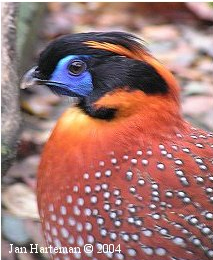 Other Names: Crimson Bellied Tragopan, Chinese Crimson Pheasant, Temminck’s Horned Pheasant
Other Names: Crimson Bellied Tragopan, Chinese Crimson Pheasant, Temminck’s Horned Pheasant
Range: The most widespread of the genus, this Tragopan is found in northeastern India through Myanmar (Burma) to northern Vietnam north to central China.
Subspecies: None recognized.
Habitat: Forests, dense evergreen, bamboo and rhododendron.
Description: The head is black, forming a mask around the blue facial skin that is extended during courtship; deep orange-red on crest, neck and breast; some males with bright orange collar; rest of body crimson, covered with gray spots on lower breast and black-lined white spots on wing coverts, back and upper tail coverts. Compared to the similar Satyr Tragopan, tail shorter, underparts grayer, overall lighter and more extensive facial skin.
Description, female: Upper parts varying from rufous to greyish brown, never as reddish as in some satyra, nor as grey as in caboti, strongly mottled with blackish, with arrow-shaped mark of pale buff to greyish white; chin and throat buff to whitish, with black lines; under parts light brown with large whitish spots and black patches.
Avicultural Data
Status in Aviculture: Well established; the most commonly seen of the genus in captivity. A 2004 survey showed the Temminck’s Tragopan to be the one of the most popular and commonly kept pheasant species in North America.
Breeding Season: Late April through June.
Breeding Age: Second year, although first year hens may lay fertile eggs if kept with an older male. Elevated nesters.
Clutch Size: 3-6
Incubation Period: 28 days
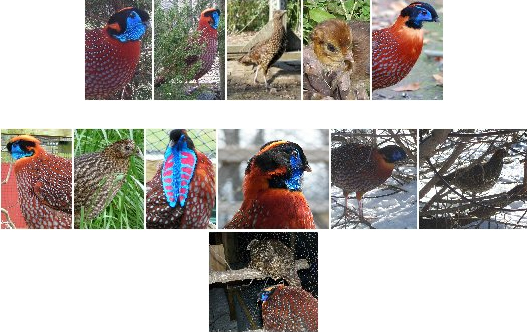
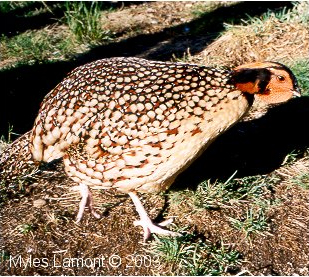 Other Names: Yellow-bellied Tragopan
Other Names: Yellow-bellied Tragopan
Range: Resident in Zhejiang, Jiangxi, Hunan, Guangdong, Guangxi and Fujian.
Subspecies: Two, Tragopan caboti caboti, T. c. guangxiensis
Habitat: Inhabits coniferous or broadleaved woods with undergrowth, mountain stream sides, slopes, terraces and damp places under cliffs. Feeds on the ground or in trees. Descends to the ground before dawn, even in freezing weather; back to dwelling trees at dusk with male flying up first and female following suit.
Description: Head is black surrounding yellow-orange orbital skin; crest is red-orange; elow plain pale buff, above maroon red spotted buff. guangxiensis has darker maroon on back and rump. The female is mottled black and rufous brown above with whitish triangular patches, below greyish brown with large white markings.
Breeding Season: March to April.
Breeding Age: Second year.
Clutch Size: 2 to 4
Incubation Period: 28 days.
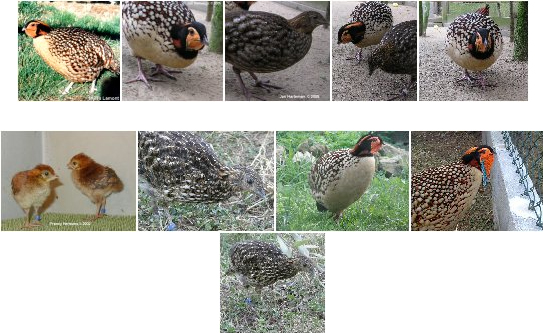
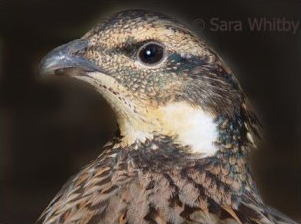 Other Names: Koklass Pheasant
Other Names: Koklass Pheasant
Range: This species has a wide range across asia, from Afganistan to China. The range is not continuous and in some cases the subspecies are seperated by quite a distance. Of the most common subspecies kept in American aviculture, the nominate race, the Indian or Common Koklass, is found in north-central India and southern Nepal; the Western Koklass is found in eastern Afghanistan and Pakistan and the Yellow-necked Koklass is native to north-eastern China.
Subspecies: Indian Koklass (Pucrasia macrolopha macrolopha), Western Koklass (P. m. castanea), Kashmir Koklass (P. m. biddulphi), Meyer’s Koklass (P. m. meyeri), Orange-collared Koklass (P. m. ruficollis), Yellow-necked Koklass (P. m. xanthospila), Joret’s Koklass (P. m. joretiana), Darwin’s Koklass (P. m. darwini).
Habitat: In mountainous areas of coniferous or mixed forests.
Breeding Season: April to June.
Breeding Age: First year.
Clutch Size: 9-12 eggs.
Incubation Period: 26-27 days.
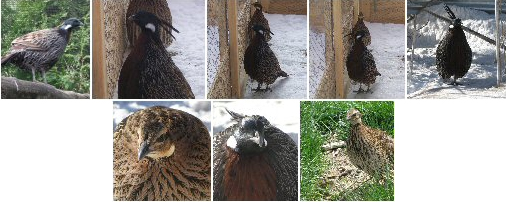
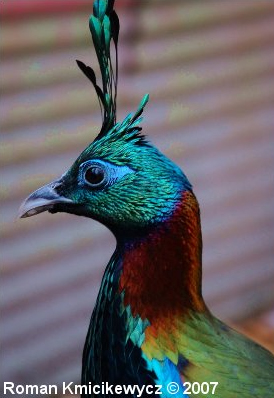 Other Names: Impeyan Pheasant, Impeyan Monal
Other Names: Impeyan Pheasant, Impeyan Monal
Range: The Himalayas, from eastern Afghanistan to western China
Subspecies: None recognized at this time, but current studies may place birds in northwestern India has a new subspecies as they lack the white rump and have more green on breast.
Habitat: Mountainous regions; in summer, they are found in rocky, grass covered meadows and winters in coniferous and mixed forests.
Description: The males are adorned with beautiful metallic colors of green, purple, red and blue; they also have a large white patch on the rump. The breast and underparts are black and the tail is copper. You can see from the photograph on the right, that the males also have a very long crest, much like a peacock. The male also has a bare patch of turquoise blue skin around the eye.The hens, while much duller than the male, are still attractive. They are basically mottled brown overall, with black, buff and white streaks. Her throat is white and she has a short crest. Hens also have the blue patch around the eyes. First year males resemble the hens, but are larger and have black feathers on the neck and breast.
Status in Wild: Considered stable throughout much of its range, but may have been eliminated in Afganistan.
Interesting Facts: The national bird of Nepal. Commonly called the Impeyan after Lady Impey who first kept them in captivity.
Status in Aviculture: The Himalayan Monal is the most commonly kept species of the genus Lophophorus and are well established in North American and European aviaries.
Breeding Season: Begins late April
Breeding Age: Second year.
Clutch Size: 4 to 6
Incubation Period: 28 days

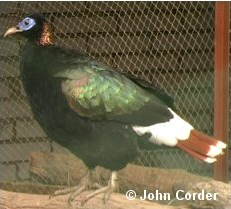 Other Names: Crestless Monal
Other Names: Crestless Monal
Range: Southeast Tibet, Southwest China, Northeast Burma.
Subspecies: There is some debate and more research needed, but there are possibly two races recently described. L. s. sclateri and L s. orientalis.
Habitat: Rhododendron thickets and undergrowth to the alpine zone at altitudes of 11,000 to 12,000 feet.
Description: Unlike the other two Monal species, the Sclater’s male has no obvious and much shorter crest. Slightly smaller than the Impeyan, the crown is bluish green, the sides of the neck are metallic reddish bronze; the facial skin is blue. The rest of the upper parts metallic green, blue and black. A most noticeable feature is the white back and rump that extends to a broad chestnut band on the tail which is tipped with white. orientalis males have a narrower tail band. Females are darker than other Monals and with no crest, tail tipped with white and shorter; overall brown with fine barring of dark brown and buff on breast.
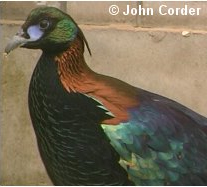 Other Names: Chinese Impeyan
Other Names: Chinese Impeyan
Range: Central China
Habitat: Coniferous forests and alpine meadows up to 16,000 feet and 9,000 feet in winter.
Brief Description: The largest of the Monals. Male similar to the Himalayan Monal, but having a bushy, drooping crest which is an ireidescent purple-bronze; the head is metallic green; orbital skin blue; hindneck and mantle coppery gold; neck, throat and chin black; lower back is white (concealed when not in flight); underparts black. The female differs from impeyanus in have a blacker back with the feathers barred; the lower back is white. Underparts blackish-brown, with buff streaks.
Status in Aviculture: Not kept in private collections. It is believed that the only birds in captivity outside of China are at the San Diego Zoo.
Clutch Size: 3 to 5 eggs.
Incubation Period: 28 days.
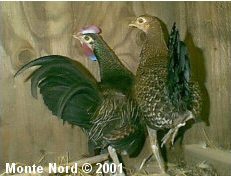 Other Names: Javan Junglefowl
Other Names: Javan Junglefowl
Range: Java and surrounding islands.
Subspecies: None.
Habitat: Forests and cultivations near the coast.
Description: Easily distingushed from the other Junglefowl by the large undented comb. The comb is light blue at the bottom near the head and purplish-red elsewhere; there is only on throat lappet or wattle that is colored the same, but with the blue on the outside edges and a yellow patch nearest to the throat. The overall plumage is metallic green and black with patterns on the neck and nape of lighter green and blue; the wings coverts are covered with bronze hackles. The tail is held lower than in other Gallus species; the rump also with narrow hackles that are dark green with yellow borders..
Description, Female: The hen is also much darker than other Junglefowl and is more pheasant-like in size and appearance when compared to the related species. She has no visible comb, birds with so are often hybrids with Red Junglefowl or domestic fowl. Her overall plumage is dark brown above mottled with dark green feathers that form a scaly appearance; light brown below with less mottling.
Status in Wild: Not much is known of its habits in the wild. It is believed that residents of the less populated areas of Java capture and breed Green Junglefowl with their own domestic fowl.
Breeding Season: Mid April to June.
Breeding Age: Some are fertile the first year, however, they are not fully mature until the second year.
Clutch Size: 5 to 10 eggs.
Incubation Period: 21 days.

Other Names: Sonnerat’s Junglefowl
Range: Central and southern India
Subspecies: None
Habitat: Varied, from dense jungle and bamboo forests to clearings and villages near humans.
Description: The comb is red and dented, similar to that of the Red Junglefowl. The long neck hackles, which are much sought after by fly-tyers, are dark gray to black with white and yellow bars. These are lost each summer during the eclipse. The back and rump feathers are grayish-black with white streaks. Tail is black with a purple sheen. First year males will have shorter and duller feathers.
Description, Female: Darker than Red Junglefowl, the head is brown with light streaks on the forehead. The comb is very small and is dull red. The back, rump and wings are mottled brown and black; the breast is white, abdomen light buff and the flanks light brown.
Status in Wild: Status is very good since it has adapted to live near humans.
Breeding Season: March to July.
Breeding Age: Second year.
Clutch Size: 4 to 6.
Incubation Period: 21 days.
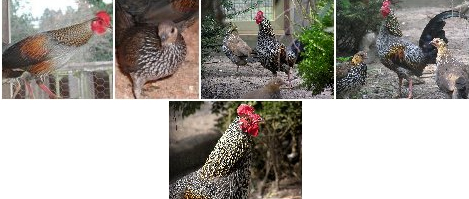
Other Names: LaFayette’s Junglefowl, Sri Lanka Junglefowl
Range: Endemic to Sri Lanka (Ceylon)
Habitat: Varied, from dry coastal scrub to montane rainforests; wary of man and stays away from villages, but will venture into cultivated areas and plantations in search of food.
Breeding Season: Varies on climate, generally begins in April and lasts through June.
Clutch Size: 3 to 6
Incubation Period: 20-21 days

Range: Throughout most of southeast Asia, from Paksitan and India eastward and south through Sumatra and Indonesia; domesticated form found worldwide.
Subspecies: There are five subspecies with variation in size of facial wattles & combs, length and color of the neck hackles in males. Cochin-Chinese (G. g. gallus), Burmese (G.g. spadiceus), Tonkinese (G. g. jabouillei), Indian (G. g. murghi) and Javan (G. g. bankiva).
Habitat: Varied, most types of forests present in southeast Asia, field edges, groves and scrubland.
Description:
Status in Wild: Generally considered common and widespread, but there is a strong possibility that a large number of wild birds have bred with feral domestic chickens.
Interesting Facts: Is the ancestor of all domestic chickens.
Breeding Season: Typically, March through June.
Clutch Size: 5-6
Incubation Period: 18-21 days

Range: China, from southeastern Tibet and western Szechuan, southern Qinghai, northwestern Yunnan.
Subspecies: There are four subspecies generally recognized, their geographical/common names: Szechuan C. c. crossoptilon, Dolan’s C. c. dolani, Tibetan or Drouyni C. c. drouyni, Yunnan C. c. lichiangense. The Harman’s Eared-Pheasant C. harmani, sometimes classed as a subspecies
Habitat: Rocky hillsides in coniferous forests, also in mixed forests in summer to the snow line.
Description: A distinctive large, overall white pheasant, with a velvety black crown, red facial skin and dark tail. Unlike other members of the genus, the ear-tufts are quite small and they carry a smaller, less ornate tail. Sexes are generally similar, but the hens are usually smaller.
Subspecies Variation: C. c. crossoptilon – Pure white chin, rest of body off-white, wing coverts tinged with gray; primaries dark gray to brown. C. c. lichiangense – Much like crossoptilon, but wings are lighter gray. C. c. drouyni – Whitest of the races, there is some light gray on the mantle; wings are white. C. c. dolani – Ashy gray overall with a white belly; wings are pale gray.
Breeding Season: Late April to June.
Breeding Age: Second year
Clutch Size: 4-7
Incubation Period: 24-25 days

Tibetan Eared-Pheasant (Crossoptilon harmani)
 Other Names: Harman’s Eared-Pheasant, Elwe’s Eared-Pheasant
Other Names: Harman’s Eared-Pheasant, Elwe’s Eared-Pheasant
Range: Southeastern Tibet, extreme northwestern India
Subspecies: Monotypic; sometimes classed and once known as subspecies Crossoptilon crossoptilon harmani.
Habitat: Mixed coniferous forest and clearings
Description: Head and face much like crossoptilon with shorter ear-coverts than auritum and mantchuricum. Overall plumage color not unlike auritum, but with a white patch on belly and rump much paler gray. Sexes are similar.
Brown Eared-Pheasant (Crossoptilon mantchuricum)
Other Names: Manchurian Eared-Pheasant
Range: Northeastern China
Subspecies: Monotypic
Habitat: Mountainous, mixed coniferous and decidous forests.
Description: Large brown pheasant, the top of the head is covered with velvety black feathers, the “ears” are white and start beneath the chin and extend back over the ears. The facial skin is scarlet red. The neck is black with a purplish sheen that shades into brown on to the lower back and wings. The base of the tail is silvery gray, the plumes of the tail are dark brown. Immature birds are mottled brown and will attain adult plumage by five months. Sexes are similar, but can be distinguished by looking at the spur. The spurs on the males are larger and round. The female’s are much smaller and are oblong in shape. The spurs will begin to be noticeable at about four months of age.
Breeding Season: April to June.
Breeding Age: Second year.
Clutch Size: 5 to 8 eggs.
Incubation Period: 26-27 days.
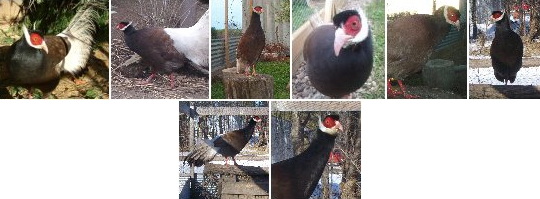
Blue Eared-Pheasant (Crossoptilon auritum)
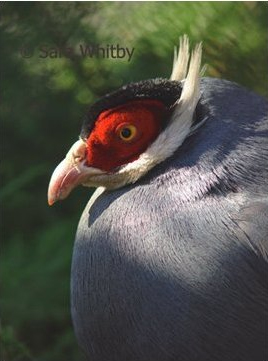 Range: Central China
Range: Central China
Habitat: Coniferous forests up to 11,500 feet
Description: Distinctive and easily identified. The top of the head is covered with velvety black feathers, the “ears” are white and start beneath the chin and extend back over the ears. The facial skin is scarlet red. The rest of the body is bluish-gray. Immature birds are mottled gray-brown and will attain adult plumage by four months. Sexes are similar, but can be distinguished by looking at the spur. The spurs on the males are larger and round. The female’s are much smaller and are oblong in shape. The spurs will begin to be noticeable at about four months of age.
Status in Wild: Stable and the most common of the genus. Not endangered or threatened at this time.
Breeding Season: April through June
Breeding Age: While first year birds will lay, breed and are sometimes fertile, breeding results are best obtained with second year birds.
Clutch Size: 6 to 12
Incubation Period: 26 days

Kalij Pheasant (Lophura leucomelanos)
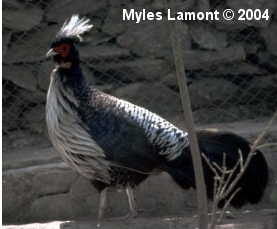 Subspecies & Range: Nine were recognized by Delacour, but two races L. l. lineata andL. l. crawfurdi, are sometimes considered races of the Silver Pheasant L. nycthemera.
Subspecies & Range: Nine were recognized by Delacour, but two races L. l. lineata andL. l. crawfurdi, are sometimes considered races of the Silver Pheasant L. nycthemera.
White-crested Kalij (L. l. hamiltoni), western Himalayas to extreme western Nepal; Nepal Kalij (L. l. leucomelanos), endemic to Nepal; Black-backed Kalij (L. l. melanota), northwest India and western Bhutan; Black Kalij (L. l. moffitti), range uncertain, believed to be central Bhutan; Black-breasted or Horsfield’s Kalij (L. l. lathami), eastern Bhutan and northeastern India east to Burma (Myanmar); William’s Kalij (L. l. williamsi), western Burma; Oates’ Kalij (L. l. oatesi), southern Burma; Lineated Kalij (L. l. lineata), eastern Burma, northwestern Thailand; Crawfurd’s Kalij (L. l. crawfurdi), southeastern Burma, southwestern Thailand.
Habitat: Varied; from mountainous forests to lowland cultivated lands and forests, depending on race.
Description: Considerable variation between the races; western Kalij (sometime known as the Blue or Himalayan Kalij in captivity) tend to be overall dark blue. The eastern Kalij, also known as the Grey Kalij, have more vermiculations and barring, much like Silver Pheasants. (see taxonomy notes below).
Of the subspecies that are kept in captivity, the White-crested Kalij L. l. hamiltoni is perhaps the most common. It is the only subspecies with a light crest. Native to the western Himalayas from the Indus River east to western Nepal, where it possibly intergrades with the Nepal Kalij. Their status in the wild seems secure and are considered to be quite common in northwest India. White-crested Kalij frequent elevations up to 11,000 feet in evergreen and decidous forests.
Male: Long and rather thin crest of disentegrated white or pale grayish brown feathers falling on the nape; head and neck purplish black; mantle glossy bluish black, the feathers with pale grey edges and a white shaft; feathers of middle and lower back, rump and lesser tail coverts black with an indistinct narrow suberterminal brown line and a broad terminal white fringe 5mm wide; tail black, brownish at tips; primaries and secondaries blackish brown; chin and throat brownish black; breast and sides of body covered with long, lanceolate feathers dark brownish grey at the base, light grey to whitish at the tip; those of the flanks and abdomen are broader, dark grey with pale edges and a white shaft. There is much variation in the color of the crest and of the breast feathers. Iris brown to orange; face wattles scarlet, with tiny black featherlets; bill greenish white, more or less tinged with blackish at the base and on culmen; legs pale brown to grey. Length: 650-730 mm.; wing: 225-250 mm.; culmen: 23-30 mm.; tarsus: 75-80 mm.
Female: Long crest dull brown with pale shafts; body plumage pale brown, inconspicuously vermiculated with blackish, each feather with a pale shaft and a light grey border which is missing in the flight feathers; two or four central rectrices brown vermiculated and streaked with black and buff; the others blackish with pale tips; belly paler. There is a good deal of individual variation in the depth and shade of the brown. Soft parts as in the male, but browner. Length: 500-600 mm.; wing: 203-215 mm. tail: 205-215 mm.; culmen: 20-25 mm.; tarsus: 65-70 mm.
Immature: Dark brown, the head more rufous; ear-coverts blackish; upper plumage freckled with black, each feather with a subterminal black and a terminal rufous buff border; under parts lighter with a terminal whitish spot.
Downy Chick: Head and upper back chestnut with a dark line from eye to nape as in all species of the genus; upper parts dark brown with two broad lateral whitish buff bands; under parts whitish, wing mottled brown and buff; legs reddish flesh.
The Nepal Kalij L. l. leucomelanos replaces the White-crested in central Nepal. Inhabits similar mountainous forested habitats from 4,000 to 6,000 feet. Has been introduced and is now established in the Hawaiian Islands. Nepal Kalij are often seen in captivity, but they are not as popular with many due to their rather drab plumage. In the wild, the populations are stable and not threatened.
Males can be distingushed from hamiltoni in having a dark and slightly shorter crest. I’ve seen and talked with others that there is a good deal of variation among captive males (this raises the validity of pure stock in America), but according to Delacour, the white fringed feathers of the lower back and rump are more narrow than hamiltoni; also on the mantle, there should be little or no gray edging to the feathers. Hens can be tough to distinguish from hamiltoni, they are generally darker and the gray borders of the feathers more noticeable. If you are raising both White-crested and Nepal, please be sure to band or mark the birds to keep lines separate. I’ve once puchased a young so-called Nepal pair in the past, only to see the crest turn light as the male grew older.
The Black-breasted Kalij L. l. lathami is also known as the Horsfield’s Kalij, this subspecies is seen in a few American aviaries. They are found in evergreen and deciduous forests in eastern Bhutan and northeastern India east to Burma. Has the largest range of the kalij and is still considered common in the wild. Much overall darker than the two mentioned with no lanceolated markings on the breast and underparts; the only barring is found on the rump; the crest is much more upright in stance as well. Hens are also darker than the mentioned races with only faint barring.
It is very doubtful that there are any pure Black-backed Kalij L. l. melanota or Black Kalij L. l. moffitti left in American aviaries. It has been many years since these birds were last imported and any that are attempted to be passed as these races are more than likely hybrids. melanota resemble leucomelanos, overall darker and males lack the white fringe on the rump, but do have a pale gray breast; hens are dark brown wuth light borders to the feathers and a white throat; the crest of both sexes are much shorter than the mentioned. moffitti is entirely black, dark back like melanota and dark breast like lathami; hens are much like melanota, but the throat is buff. Two other races, William’s Kalij L. l. williamsi and Oates’ L. i. oatesi have never been kept in captivity in the US (not sure about collections overseas). williamsi resemble lathami, but much more vermiculated and appear gray overall.
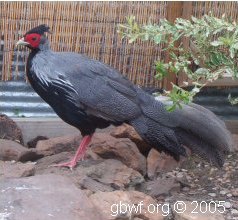 The two Grey Kalij races consist of the Lineated Kalij L. l. lineata males with very fine vermiculations of black and white on upperparts that give gray apperance with white streaked feathers on the side of the breast; the crest, chin, breast and belly is black; tail long with central feathers buffy-white. Hens are brown above with a dark brown crest, the breast and abdomen with white v-shaped streaks that are bordered with black; both sexes have brownish to gray legs. Crawfurd’s Kalij L. l. crawfurdi resemble lineata, but legs are reddish and the vermiculations of the back and sides wider and coarser, tail is shorter; hens are darker with very dark, almost black underparts, white v-like streaks wider and bolder.
The two Grey Kalij races consist of the Lineated Kalij L. l. lineata males with very fine vermiculations of black and white on upperparts that give gray apperance with white streaked feathers on the side of the breast; the crest, chin, breast and belly is black; tail long with central feathers buffy-white. Hens are brown above with a dark brown crest, the breast and abdomen with white v-shaped streaks that are bordered with black; both sexes have brownish to gray legs. Crawfurd’s Kalij L. l. crawfurdi resemble lineata, but legs are reddish and the vermiculations of the back and sides wider and coarser, tail is shorter; hens are darker with very dark, almost black underparts, white v-like streaks wider and bolder.
Status in Wild: As a species, they are considered safe and unthreatened. The races in the west are common in most areas, the eastern races are considered vulnerable.
Taxonomy Data: Sometimes placed in the genus Gennaeus. Species name sometimes spelled leucomelana. L. l. lathami sometimes known as L. l. horsfeldii. Recent DNA work published in the Ibis, notes that two races (lineata & crawfurdi) should belong with leucomelanos instead of nycthemera. Click here to view the article in PDF format. If new data becomes available for nycthemera and leucomelanos, I will be sure to include it on this site.
Breeding Season: As with most species, it vaires with climate. They seem to be among the last species to begin laying (Missouri) for me. The Horsfield’s would start the in the middle of May, Nepal and White-crested in early June.
Breeding Age: Males will attain their adult plumage their first year and are often fertile at this age as well. First year hens will lay and are sometimes fertile.
Clutch Size: 6-9 eggs.
Incubation Period: Captive birds average about 22-23 days. In the wild, the races in the cooler areas incubate for 22 days and 20 days in the warmer areas. Should be encouraged to allow the hens to set, they are great mothers.
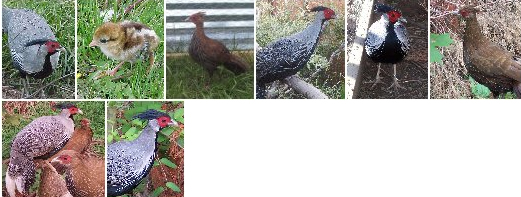
Silver Pheasant (Lophura nycthemera)
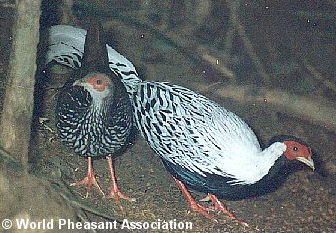 Other Names: No general names, see the list of subspecies for geographical names.
Other Names: No general names, see the list of subspecies for geographical names.
Range: South-western China, eastern Burma, southern Vietnam, southwestern Cambodia, southeastern Thailand, northern Laos and the island of Hainan.
Subspecies: 15 subspecies according to Johnsgard, 1999. True Silver Pheasant (Lophura nycthemera nycthemera) being the most commonly claimed in aviaries. The True Silver is the largest of the subspecies and is found in southeastern China. The other subspecies include the Lewis’ Silver Pheasant (L. n. lewisi), the Annamese Silver Pheasant (L. n. annamensis), the Boloven Silver Pheasant (L. n. engelbachi), the Bel’s Silver Pheasant (L. n. beli), the Berlioz’s Silver Pheasant (L. n. berliozi), the Ruby Mines Silver Pheasant (L. n. rufipes), the Rippon’s Silver Pheasant (L. n. ripponi), the Jones’ Silver Pheasant (L. n. jonesi), the Western Silver Pheasant (L. n. occidentalis), the Lao Silver Pheasant (L. n. beaulieui), the Fokien Silver Pheasant (L. n. fokiensis), the Hainan Silver Pheasant (L. n. whiteheadi), Szechwan Silver Pheasant (L. n. omeiensis) and the Rang Jiang Silver Pheasant (L. n. rongjiangensis).
Two additional subspecies that are often considered Silver Pheasants are the Crawfurd’s Kalij Lophura nycthemera crawfurdi and the Lineated Kalij Lophura nycthemera lineata. Recent DNA work published in the Ibis, notes that these races should be belong with leucomelanos instead of nycthemera. Click here to view the article in PDF format. If new data becomes available for nycthemera and leucomelanos, I will be sure to include it on this site.
Habitat: Diverse, both grasslands and bamboo, evergreen and decidous forests.
Description: The male True Silver L. n. nycthemera has a long black crest, a black chin and throat, with a glossy bluish-black belly. The rest of the body is white, with many black lines. Their tails can be quite long, with the central feathers pure white. One of the most noticeable features are the bright red face wattles which are used during courtship. Silvers do not acheive their brillant plumage until their second year. First year males often have many black markings on the chest, while the rest of the body is mostly brown with light gray streaks. Hens are drab, olive brown overall. There is much varation from hen to hen in the streaking of the belly, and I have never seen two hens exactly alike. Hens have a much smaller and paler face wattle. The bill is gray and the feet red. Immature Silvers resemble hens, but are often lighter or paler.
Breeding Season: Silver are among the first birds to begin laying. Don’t be surprised to find an egg when there is still snow on the ground! In Missouri, my birds would begin to lay in late February and early March, slowing down in May.
Breeding Age: Second year, but first years birds are often fertile.
Clutch Size: 6 to 15
Incubation Period: 26-27 days.

Jones’ Silver Pheasant, Lophura nycthemera jonesi

Annamese Silver Pheasant, Lophura nycthemera annamensis
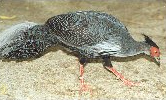
Lewis’ Silver Pheasant, Lophura nycthemera lewisi
Edward’s Pheasant (Lophura edwardsi)
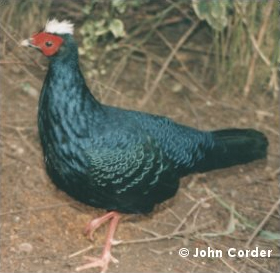 Other Names: Annam Pheasant; hatinhensis – Hatinhensis Pheasant, Vo Quy’s Pheasant, Vietnamese Fireback
Other Names: Annam Pheasant; hatinhensis – Hatinhensis Pheasant, Vo Quy’s Pheasant, Vietnamese Fireback
Range: Central Vietnam.
Subspecies: A possible race is the Vietnamese Pheasant L. e. hatinhensis. hatinhensis has a more northern range than edwardsi, which occurs to the south in north-central Vietnam and found in dense coastal-plain forests. DNA studies are ongoing to determine if the Hatinhensis is indeed a subspecies, a true species or perhaps even an inbred population of Edward’s Pheasants.
Habitat: Forests
Brief Description: They are a small species, with males being metallic blue with many shades that are seen in the sun light. The crest is white and shorter than most Lophura species; he has bright red facial wattles, red feet and a short tail. Hens are much duller, being overall brown with no visible crest. She has smaller and paler face wattles and red legs. Males will gain their adult plumage the first year.
Breeding Season: Varies among climate and region; usually begins in late March in the central US.
Clutch Size: 4 to 7

Swinhoe’s Pheasant (Lophura swinhoii)
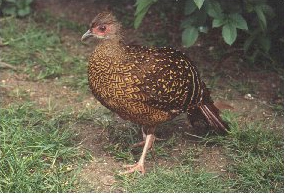 Other Names: Formosan Pheasant, Blue Pheasant
Other Names: Formosan Pheasant, Blue Pheasant
Range: Mountains of central Taiwan.
Habitat: Forests.
Description: Adult males are larger than the similar edwardsi and also differ in having a short white crest, a blue head, neck and breast, but the red face wattles are much more developed. There is a large white patch on the upper back, the shoulders are maroon and the wing-coverts are metallic greenish-black. The long central tail feather is white. Hens are mostly brown, speckled with triangular yellowish-buff markings. First year males look similar to adult males, but are duller and the white patch on the back is mottled brown.
Breeding Season: Begins early here in the midwest, not uncommon to have hens lay in early March and usually lasts through mid May.
Breeding Age: Second year, but first year birds are often fertile.
Clutch Size: 3 to 6
Incubation Period: 24-26 days
Salvadori’s Pheasant (Lophura inornata)
Other Names: Sumatran Pheasant
Subspecies: The extremely rare Aceh L. hoogerwerfi from northern Sumatra is sometimes considered a subspecies. The nominate race, inornata is found in southwestern Sumatra.
Range: Sumatra
Habitat: Montane Rainforests
Description: Small, short-tailed and crestless species, somewhat resembles crestless firebacks. Males are bluish-black overall with red facial skin and gray legs. Females are chestnut-brown overall with buff streaks. From what is known, hoogerwerfi males are believed to be dark like the inornata males; females are darker and lack the buff mottling of female.
Interesting Facts: Common name originated from Tommaso Salvadori (1835-1923), an Italian ornithologist who was Vice Director of the Museum of Zoology at the University of Turin. The species was described by Salvadori in 1879. The species name inornata is latin for nonornamental.
Clutch Size: 2
Incubation Period: 22 days

Crestless Fireback Pheasant (Lophura erythropthalma)
Other Names: Rufous-tailed Pheasant
Range: Malayan Peninsula, Sumatra and Borneo.
Subspecies: Two, the Malay (Lophura erythrophthalma erythrophthalma) and the Bornean (L. e. pyronota).
Habitat: Tropical forests.
Male: Head crestless; face-wattles scarlet, large, the two upper lobes high and pointed in display; crown, throat, ear-coverts and neck purplish black; mantle, wings and sides of body purplish black finely vermiculated with silvery grey; middle back metallic dark purple with maroon fringes; tail of fourteen or sixteen cinnamon rectrices, the middle pair a little shorter than the second and third, rounded, short and straight, held slightly upwards and looking like that of a domestic hen; breast purplish black. Iris reddish brown; bill greenish white, blackish at base; legs bluish grey, with a strong spur. Young males assume the adult plumage at the age of four months.
Female: Entirely black except for the brownish head and smoky chin and throat; the feathers are strongly glossed with steel blue in their exposed part except on the abdomen, thighs, and vent. Iris brown; bill black, pale at lower base; facial wattles scarlet; legs bluish grey, always with a sharp spur as in the male, but smaller. Hens erythrophthalma resemble cocks inornata, but are distinguished by the absence of iridescent blue fringes to the feathers, the heavier build and the dark bill.
Male: Differs from erythrophthalma in having the neck and upper back light grey finely speckled with black, with white shaft-lines; sides of body and breast feathers lanceolate, purplish black with wide white shaft lines; the rump is dark maroon and the upper tail-coverts steel blue; retrices black at the base.
Female: Similar to erythrophthalma, perhaps a little more metallic and larger, but usually indistinguishable.
Breeding Age: Second year.
Clutch Size: 3 to 6.
Incubation Period: 24 days.

Siamese Fireback (Lophura diardi)
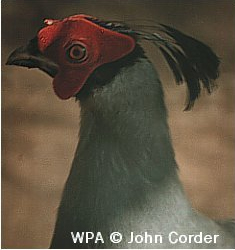 Other Names: Diard’s Fireback, Diard’s Crested Fireback, Siamese Crested Fireback
Other Names: Diard’s Fireback, Diard’s Crested Fireback, Siamese Crested Fireback
Range: Indo-China north to Vietnam to eastern Thailand.
Subspecies: None
Habitat: Very dense forests, bamboo and evergreen from sea-level to 2,000 feet.
Description: Very beautiful bird that will attain its adult plumage the first year. The crest is long and made up of purple-black feathers. The facial wattles are bright red, the throat, head and face behind the wattles are black. The breast, neck and upper back is gray with very fine vermiculations. The middle of the back is bright yellow (hence the name “fireback”), the lower back is metallic blue with chestnut fringes. The tail is long and curved with metallic black, blue and green sheens. The wings are gray with black and white streaks; the belly and lower areas are black. The bill is yellow, legs and feet red. Like other species of Lophura, they can grow fairly long spurs that the keeper will need to keep trimmed to prevent injuries to the hen when breeding.
Description, Female: Fireback hens, despite not being colorful, their unique markings make them more attractive than other pheasant hens. The Siamese Fireback hen has no crest, her facial wattles are smaller than the male’s, but just as bright. The head, throat, chin and neck are grayish-brown; the upper back and upper breast are bright chestnut. The lower back, wings and tail are chestnut, vermiculated with white and black. The bill is dark gray and the legs and feet are red.
Breeding Season: May to July.
Breeding Age: Third year, but I’ve heard from those who have had some second year males that were fertile. Males will attain adult plumage the first year, but will have smaller tails than mature birds.
Clutch Size: 5 to 8 eggs.
Incubation Period: 24-25 days.

Bulwer’s Wattled Pheasant (Lophura bulweri)
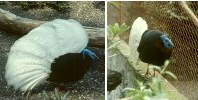 Other Names: Wattled Pheasant, White-tailed Wattled Pheasant, Bulwer’s Pheasant
Other Names: Wattled Pheasant, White-tailed Wattled Pheasant, Bulwer’s Pheasant
Subspecies: None.
Habitat: Montane tropical forest up to 5,200 feet.
Brief Description: The male is one of the most spectacular of all pheasants. The species is named for the bright blue facial wattles that are extended several inches during courtship. The curved white tail is also a noticeable feature. The general body color is dark blue to black, with the throat and upper breast purplish. The female is dull brown overall with fine black vermiculations; crestless, blue facial skin.
Status in Wild: Locally common in four protected areas in Borneo, but rare elsewhere as logging and clearing for agriculture has destroyed habitat.
Clutch Size: 5 eggs
Incubation Period: 25 days
Cheer Pheasant (Catreus wallichi)
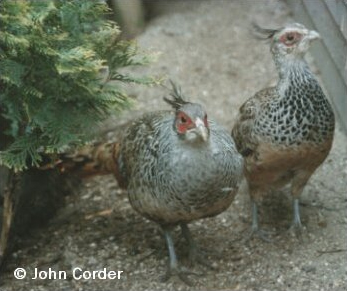 Other Names: Wallich’s Pheasant
Other Names: Wallich’s Pheasant
Range: The Himalayas, fragmented range from Afganistan to Nepal; continue to decline.
Habitat: Highland forests and scrublands from 4,000 to 10,000 Feet.
Brief Description: Drab in comparison to other pheasant species, both sexes share the long gray crests. Plumage overall buffy and gray, with black barring; the tail is long and barred buff, gray and brown. Female very similar to the male; lacking spurs, facial skin smaller, duller in plumage and slightly smaller in overall size.
Interesting Facts: Despite similarities to the genus Syrmaticus, the Cheer Pheasant is the sole member of the genus Catreus. Re-introductions of captive bred birds have taken place in Pakistan by the WOrld Pheasant Association. The scientific name, wallichi is after the Danish botanist Nathaniel Wallich who worked in India.
Breeding Season: Late April to June.
Breeding Age: First year.
Clutch Size: 9 to 12.
Incubation Period: 26 days
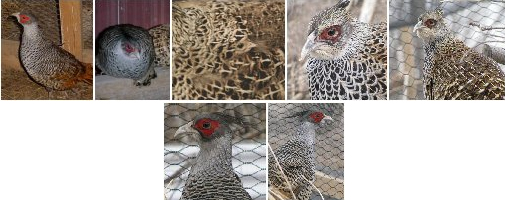
Reeves Pheasant (Syrmaticus reevesii)
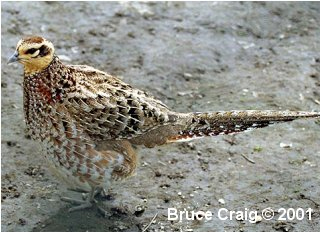 Other Names: Long-tailed Pheasant
Other Names: Long-tailed Pheasant
Range: Central China, range has been greatly reduced. Unsuccessful attempts to introduce into North America, Hawaii, England and France. Birds are still released in these areas for sport, but breeding information is unknown.
Subspecies: None.
Habitat: Forested mountains.
Description: A very familiar and well known pheasant in captivity. The males are known to grow very long tails, up to 6 feet in some cases! The crown, chin and back of head is white with a black band covering the face, eyes and extending to the back of the head. Another black band around the neck seperates the head from the black-tipped, yellow-buff plumage that is on the mantle and the back and extends to the base of the tail. The upper breast is darker chestnut to black; lower breast and side feathers are white, tipped with black. The tail is very long, white with black bars.
There is a great deal of plumage variations in captive birds. Some are seen with black feathers on the crown and the black band on the face may extend below the mandible. Other birds are seen with a darker chestnut color on the body. Some breeders feel that inbreeding over the years has contributed to this.
Description, Female: The hen is drab as in most pheasants and is smaller than the male. Her face and throat are buff, with a brown crown and band behind her eye. The overall markings are mottled brown, buff and white, which hides her very well when nesting. The tail is long and barred with buff and brown.
Status in Aviculture: Very common; most commonly seen species of the genus Syrmaticus in captivity. Due to the rapid decline of the wild population, captive breeding and genetic diversity becoming very important.
Breeding Season: Begins in late April or early May. We have had hens lay into early July.
Breeding Age: First year.
Clutch Size: 7 to 14 olive colored eggs.
Incubation Period: 24-25 days.
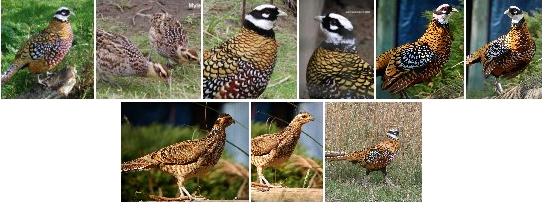
Elliot’s Pheasant (Syrmaticus ellioti)
Other Names: Bar-backed Pheasant, Chinese Barred-backed Pheasant, White-necked Long-tailed Pheasant
Range: Southeastern China
Subspecies: None.
Habitat: Thick mixed forests to about 6,200 feet.
Male. Crown chestnut-brown, the eyebrows mixed with pale grey; cheeks and ear-coverts greyish brown; sides of neck whitish grey, the hind neck darker grey; chin, throat, and forneck black; mantle and upper breast bright rufous chestnut, each feather having a subterminal black band and a metallic coppery red fringe; a white bar on the scapulars; wing rufous chestnut with a broad steel-blue band on the lesser coverts; greater coverts with a black subterminal bar and broad white tips, forming a band accross the wing; secondaries and tertiaries chestnut with a black subterminal bar and a white or grey tip; primaries dull brown; lower back and rump black barred with white; tail of sixteen rectrices with broad bars of pale grey and rufous chestnut, seperated by irregular black lines; lower breast, abdomen, and vent white, the feathers with hidden dark brown bases; thighs chestnut-brown barred with white; feathers of the flanks chestnut with broad white tips; under tail-coverts black and chestnut. Iris brown to orange; bill horny yellow; legs grey.
Female. Crown rufous brown with blackish tips to the feathers; eyebrows, face, sides, and back of neck greyish fulvous; chin, throat, and foreneck black; mantle mottled, each feather being rufous brown with an arrow-shaped white shaft-marking and a broad subterminal black bar; scapulars fulvous brown with ashy tips; wing-coverts, tertiaries and secondaries vermiculated brown and black, with a large subterminal black patch and light greyish tip; primaries brownish black with interrupted rufous borders; lower back and rump rufous brown finely vermiculated with black; upper tail-coverts chestnut with peppered, pale brown tips, the longest with indistinct bars; central rectrices plain chestnut with black subterminal bars and broad white tips; tail short and bluntly pointed; upper breast mottled fufous brown with black subterminal spots or bars; feathers of lower breast, sides and flanks brown, with a white tip that becomes very broad on the abdomen which appears white; thighs brown; under tail coverts chestnut with broad blackish borders and white tips. Iris brown; bill horny brown; legs grey.
Immature. Like the female, but duller and the throat white; young males soon show barred tail feathers.
Breeding Season: Can be as early as the middle of March in some locations, but usually April through June.
Breeding Age: The males will attain their adult plumage the first year, but are usually not fertile until they are two. I have spoken with a breeder who has had first year hens lay fertile eggs with an older male.
Clutch Size: 6 to 8 rosy-white eggs.
Incubation Period: 25 days.
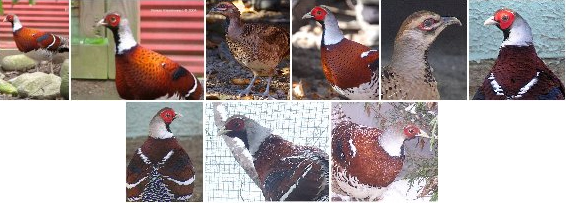
Bar-tailed Pheasant (Syrmaticus humiae)
Other Names: Hume’s Pheasant, Black-necked Bar-tailed Pheasant
Range: Northeastern India, northern Burma (Myanmar) and Thailand, southwestern China.
Subspecies: Hume’s (S. h. humiae) and Burmese (S. h. burmanicus).
Habitat: Open forests.
Description: humiae Crown and nape olive brown; throat, neck, upper breast and mantle steel blue; other body regions metallic rich chestnut with purplish tinge, three white bars seen when wing closed. The lower back and rump barred dark blue and white; tail gray with black and chestnut bars. burmanicus similar, having a more purplish tint and darker neck; the barring of the lower back darker with broader white barring.
Description, female: Subspecies very similar; much like the Elliot’s female, lacking black throat and having a barred abdomen. Overall grayish buff, mantle barred black with each feather having a white arrow-shaped marking.
Breeding Season: April-May.
Breeding Age: First year.
Clutch Size: 6-11 eggs.
Incubation Period: 27-28 days.

Mikado Pheasant (Syrmaticus mikado)
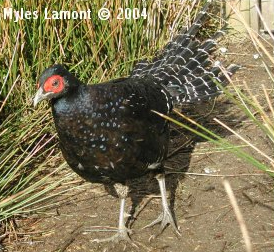 Subspecies: None recognized.
Subspecies: None recognized.
Range: Central Taiwan.
Subspecies: None recognized.
Habitat: Mountain broadleaf, coniferous and mixed forests from 5,000 to 10,000 feet.
Brief Description: Males are much darker than other species of the genus, being purplish-black overall. The tail and rump have narrow white bars as do the wing coverts. The face wattles are bright red; the bill, legs and feet are gray.
Brief Description, Female: Females are very similar to other Syrmaticus species and are often confused and inadvertently crossed with Elliot’s and Bar-tailed. Mikado hens are darker than the other species, lack the dark throat of the Elliot’s and the white markings on the breast are more pronounced than the Bar-tailed. The tail is barred with brown, black and white.
Breeding Season: Mikado have been known to lay as early as March, but April to June the most common season in America.
Breeding Age: Males will attain their adult plumage their first year and are often fertile at this age as well. First year hens will lay and are sometimes fertile.
Clutch Size: 5 to 10 eggs.
Incubation Period: 27 to 28 days.
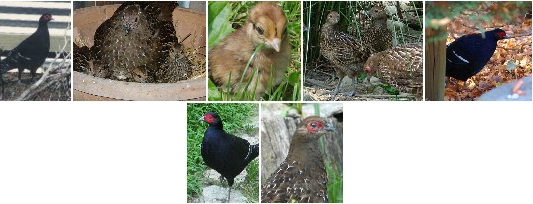
Copper Pheasant (Syrmaticus soemmeringii)
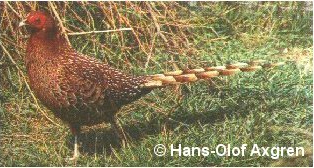 Other Names: Soemmering’s Pheasant
Other Names: Soemmering’s Pheasant
Range: Japan see below for subspecies distribution
Subspecies: Scintillating Copper (S. s. scintillans) northern and central Honshu; Shikoku Copper (S. s. intermedius) southwestern Honshu and Shikoku; Pacific Copper (S. s. subrufus) southeastern Honshu and southwestern Shikoku; Soemmering’s Copper (S. s. soemmeringii) northern and central Kyushu; Ijima Copper (S. s. ijimae) southeastern Kyushu.
Habitat: Coniferous and mixed forests.
Male: Head deep reddish chestnut; neck feathers light chestnut with large black patches near the base and a fringe of coppery purplish chestnut; mantle alike, but with pale buffy borders on the sides of the feathers turning to white on the back and rump where they become broad; the tone of the buff or white borders varies much individually; rectrices cinnamon with narrow black bars broadly bordered with dark chestnut above and with buffy, spotted with black below; there is a great deal of variation in the rectrices, the central ones having from seven to thirteen bars; breast feathers pale chestnut with black patches and pale greyish buff borders producing a laced appearance, those of the flanks and abdomen paler with a pale buff border; thighs and vent buff and chestnut marked with black and bordered with white; wing coverts and tertiaries alike, but lighter; primaries and secondaries barred with white; wing coverts and tertiaries alike, but lighter; primaries and secondaries barred and vermiculated buffy and blackish brown.
S. s. scintillans – Female: In general resemble those of ellioti and humiae, but the pale streaks on the mantle and breast are very narrow, buff and inconspicuous; crown dark brown; throat light tawny buff; cheeks, sides of neck, mantle and breasy heavily marked with blackish brown which forms an uneven dark collar below the throat; back and rump strongly tinged with grey; underparts like those of ellioti but more buffy; central rectrices barred grey and palce chestnut, vermiculated all over with brown
S. s. intermedius – Male: Similar to scintillans, but slightly darker and richer red all over, particularly on the tail which is longer, and on the abdomen which is of the same color as the breast; borders of feathers golden on most of the mantle and scapulars. Female – Like scintillans.
S. s. subrufus – Male: Differs from the proceeding subspecies in having glittering golden orange borders to the feathers of the mantle and back; those of the rump have some white but often much reduced in size; gerneral color darker red. Tail broader and lighter in color than in intermedius, but not so light as in scintillans. Very variable and unstable. Female – Like scintillans.
S. s. soemmeringii – Male: Differs from subrufus in being stil darker and redder; central rectrice very dark, broarder and not so abruptly pointed; nine to fourteen bars in the tail; all the feathers of the upper parts have golden carmine fringes, and those of the under parts are dark chestnut and black. Female – Darker and more distinctly marked than scintillans.
S. s. ijimae – Male: Similar to soemmeringii, but feathers of the back and rump with broad silky white fringes which may occupy the whole of their visible part on the rump; upper tail coverts with a thin white border; there is a great deal of variation in the width of the white fringes and in the appearance of the lower back and rump which may look pure white or red more or less spotted with white according to specimens. Female: Similar to soemmeringii
Breeding Season: Late April to early June.
Breeding Age: First year; adult plumage is also attained the first year.
Clutch Size: 6 to 12 eggs.
Incubation Period: 24 to 25 days.

Common Pheasant (Phasianus colchicus)
Other Names: Pheasant, Ring-necked Pheasant, Game Pheasant, True Pheasant; see subspecies for others.
Range: Broad range over much of temperate Asia; introduced nearly worldwide including North America, Europe, Chile, Hawaii, Tasmania and New Zealand.
Subspecies: Black-necked Pheasants – Southern Caucasus Pheasant (P. colchicus colchicus), Talisch Caucasian Pheasant (P. c. talischensis), Northern Caucasian Pheasant (P. c. spetentrionalis), Persian Pheasant (P .c. persicus); White-winged Pheasants – Prince of Wales’s Pheasant (. c. principalis), Zarundy’s Pheasant (P. c. zarudnyi), Bianchi’s Pheasant (P. c. bianchii), Khivan Pheasant (P. c. chrysomelas), Zerafshan Pheasant (P. c. zerafschanicus); Kirghiz Pheasants – Kirghiz Pheasant (P. c. mongolicus), Syr Daria Pheasant (P. c. turcestanicus); Tarim Basin Pheasants – Tarim Pheasant (P. c. tarimensis), Yarkland Pheasant (P. c. sahwii); Grey-rumped Pheasants – Kobdo Ring-necked Pheasant (P. c. hagenbecki), Manchurian Ring-necked Pheasant (P. c. pallasi), Korean Ring-necked Pheasant (P. c. karpowi), Shansi Pheasant (P. c. kiangsuensis), Alashan Pheasant (P. c. alaschanicus), Gobi Ring-necked Pheasant (P. c. edzinensis), Satchu Ring-necked Pheasant (P. c. satscheuensis), Zaidam Pheasant (P. c. vlangalii), Strauch’s Pheasant (P. c. strauchi), Sohokhoto Pheasant (P. c. sohokhotensis), Sungpan Pheasant (P. c. suehschanensis), Stone’s Pheasant (P. c. elegans), Rothschild’s Pheasant (P. c. rothschildi), Kweichow Pheasant (P. c. decollatus), Tonkinese Ring-necked Pheasant (P. c. takatsukasae), Chinese Ring-necked Pheasant (P. c. torquatus), Formosan Ring-necked Pheasant (P. c. formosanus).
Habitat: A wide variety of habitats throughout its natural and introduced range.
Breeding Season: Feb-June.
Breeding Age: First year.
Clutch Size: 6 to 12 eggs, but many more can be produced if the eggs are removed. If allowed to do so, the females will hatch their own eggs with the males assisting in the chick rearing.
Incubation Period: 23-26 days.
Southern Caucasus Pheasant, Phasianus colchicus colchicus

Bianchi’s Pheasant, Phasianus colchicus bianchii

Zarundy’s Pheasant, Phasianus colchicus zarudnyi

Green Pheasant (Phasianus versicolor)
Other Names: Japanese Pheasant, Versicolor Pheasant
Range: Japan; introduced to the Hawaiian Islands and western Europe.
Subspecies: Three: Southern Green Pheasant (P. versicolor versicolor), Pacific Green Pheasant (P. v. tamensis), Northern Green Pheasant (P. v. robustipes).
Habitat: Light wooded areas near cultivated lands and meadows.
The males have the crown green, the throat blue, and the neck purplish violet; the mantle is green with a few small buff vermiculations on its lower part; back and rump green, much tinged with olive or blusih grey; rectrices dark olive with broad, black bars and pinkish fringes; scapulars barred black and pale buff with a chestnut fringe and a green tip; wing-coverts light grey tinged with blue green, the greater part much marked with chestnut; flight feathers as in other True Pheasants; underparts dark green slightly tinged with blue or purple, the feathers, as those of the mantle, deeply indented. Size small: wing: 215-243 mm; tail: 270-425 mm; tarsus: 64-78 mm; culmen: 29-38 mm.
The female is more strongly mottled than that of colchicus; the dark part of the feathers of the mantle is black and extends right up to the narrow, pale brown border, and it has a green sheen near the tip; the under parts are more vermiculated and blotched than in any other form of True Pheasant. Wing: 195-220 mm; tail 207-275 mm; tarsus: 55-64; culmen: 25-33 mm.
Breeding Season: April to early June.
Breeding Age: First year; adult plumage is also attained the first year.
Clutch Size: 6 to 12 olive eggs.
Incubation Period: 23 to 25 days.
Northern Green Pheasant, Phasianus versicolor robustipes
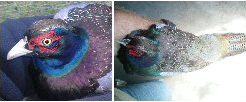
Southern Green Pheasant, Phasianus versicolor versicolor
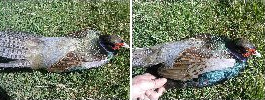
Golden Pheasant (Chrysolophus pictus)
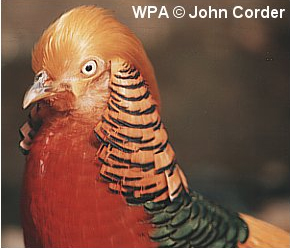 The Golden Pheasant is one of the most popular of all pheasant species kept in captivity. It is very beautiful, hardy, easy to keep and great for beginners. The Golden has been kept in captivity since as early as 1740 and perhaps was the first type of pheasant brought to North America. There is evidence that George Washington may have kept them at Mt. Vernon! For being so well known and familiar in captivity, very little is known of their habits in the wild, in the mountains of central China.
The Golden Pheasant is one of the most popular of all pheasant species kept in captivity. It is very beautiful, hardy, easy to keep and great for beginners. The Golden has been kept in captivity since as early as 1740 and perhaps was the first type of pheasant brought to North America. There is evidence that George Washington may have kept them at Mt. Vernon! For being so well known and familiar in captivity, very little is known of their habits in the wild, in the mountains of central China.
This species, along with the Lady Amherst Pheasant (C. amherstiae), make up the group of pheasants called the Ruffed Pheasants, genus Chrysolophus. They are named for their cape or ruff which they spread around their face and neck during courtship. Since these two species are so closely related, many breeders have crossed them, making “pure” Goldens and Amhersts hard to find in captivity.
The wild form of the Golden is often called the Red Golden in captivity, and the males are one of the most brilliantly colored of all birds. The adult males should have a full, silky golden-yellow crest with perhaps a slight tinge of red at the tip. The face, throat, chin and the sides of the neck are rusty tan; the wattles and orbital skin are yellow. The ruff or cape is a pale fulvous to a light orange, with each feather with a bluish-black border. The upper back is green and the rest of the back and rump is a golden-yellow. The breast is scarlet; the flanks and underparts are scarlet changing into a light chestnut. The tertiaries of the wing are blue and the scapulars are dark red. The central tail feathers are black, spotted with cinnamon and the tip of the tail cinnamon buff. The upper tail coverts are the same color as the central tail feathers. Immature males resemble hens, but will have a spotted tail and varied patches of red throughout the plumage.
The hen, as in most pheasants, has a much duller coloration than the male. At first site, she is an overall rufous brown with dark barring and a buff face and throat. The breast and sides are a barred buff and blackish brown. Her abdomen is a plain buff which varies from hen to hen. Both sexes have yellow legs and bill.
When purchasing adult goldens, please observe the adult male for signs of Amherst blood. The male will have the following if crossed: 1.) Any trace of red in the crest besides that at the very tip, 2.) Any traces of green in the breast, 3.) Red in the lower back or rump, 4.) Large size, 5.) Legs dark. A Golden hen should be small, also with yellow legs and no tinge of red in the crown. Immature goldens are much lighter in the overall color when compared to an Amherst, and of course, the legs will be yellow.
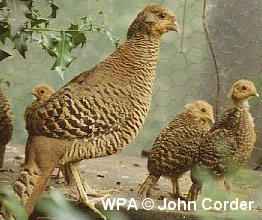 Mutations: Being an avicultural subject for so long, there is no doubt that several mutations have been developed over the years. I have serious doubt of several of the new mutations (believe many were used by crossing with Amherst) and have only included a few brief descriptions of the mutations that have been established for several years. One mutation, the Yellow Golden, is almost as common as the wild Golden in aviculture and I have provided a link with more information.
Mutations: Being an avicultural subject for so long, there is no doubt that several mutations have been developed over the years. I have serious doubt of several of the new mutations (believe many were used by crossing with Amherst) and have only included a few brief descriptions of the mutations that have been established for several years. One mutation, the Yellow Golden, is almost as common as the wild Golden in aviculture and I have provided a link with more information.
The Dark-throated Golden was the first mutation developed from the golden pheasant, however, there is recent information that disputes validity of this being a pure mutation. This dark bird was first seen in the 1860s. The adult male resembles a normal golden, but is darker with a smoky-black face and throat. The tail is also barred and not spotted as in the normal form. The hen is easily distinguishable from a normal hen. She is much darker all around with dark barring. The chicks differ from normal goldens in being dark brown with white spots. There are many indications that these birds could in fact be derived from Amherst crossings.
The Yellow Golden, also known as the Ghigi golden, was developed around the middle of this century by the Late Professor A. Ghigi of Bologna, Italy. see provided link for more information
Another mutation, the Cinnamon Golden was developed by William Petzold of Conecticut in the early seventies. The adult male is similar to the normal form, and at first glance, many believe that it is, but they have lost the metallic green on it’s back and the blue on it’s wings. Both have been replaced with a glossy gray. The ruff, crest and rump appear a darker yellow – almost orange. The cinnamon generally appears more glossy in appearance than the normal golden. The hens are readily distinguishable from other mutations by being an overall reddish cinnamon color with dark barring. Over the past several years, this mutation has gained in popularity and is now quite common in aviaries. As in the other brightly colored mutations, the male cinnamon golden’s plumage will fade in direct sunlight.
I would like to stress that the mentioned birds, with the possibility regarding the dark-throat, are mutations of the true golden pheasant and NOT hybrids with the Amherst. Since these birds are so closely related, they will cross with the offspring being fertile. There are endless color combinations in these hybrids, but are useless to aviculturists who want to keep pure species, the way nature intended them. Therefore, I would not recommend crossing these two, or any species, of pheasants just to see “what comes out”. In the past year, I was e-mailed photos of hybrids that one person was claiming were “White-ruffed Golden Pheasants”. Just be careful when dealing with someone who claims to have new mutations. Request photos and as much informaiton regarding their development as possible.
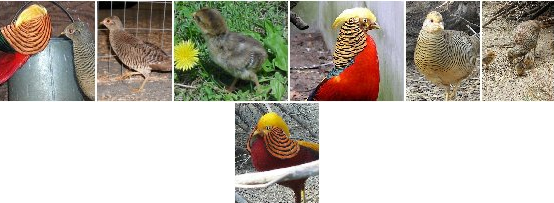
Lady Amherst Pheasant (Chrysolophus amherstiae)
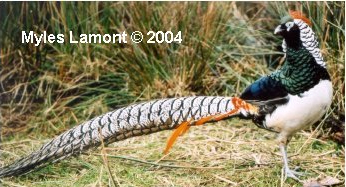 Subspecies: None.
Subspecies: None.
Range: Southwestern China & northern Burma. Has been introduced and is breeding locally into parts of Great Britain. Attempted introductions have taken place throughout the world, including New Zealand and Hawaii. Birds may also be seen in a semi-feral state in the US, mostly escapes from aviaries or purposely released. It is doubtful there are any breeding populations here.
Habitat: Forested areas and bamboo thickets.
Male
Head & Neck – Crown: Short metallic green; Crest: Crimson, narrow, stiff elongated feathers; Face & Throat: Black with metallic green spots; Bare Facial Skin & Lappet: Bluish or bluish-green; Ruff: White, rounded feathers with a blue or black border; Beak: Bluish gray Iris: Yellow. Body – Mantle: Metallic bluish green, rounded feathers with a black border edged with scintillant (sparkling) green; Upper & Middle Back: Black with a green bar and a wide buffy yellow fringe; square, broad feathers; Rump: Black with a green bar and a vermilion fringe (like an irregular patch), square, broad feathers; Breast: Metallic bluish green, rounded feathers with a black border edged with scintillant green which is wider and brighter than mantle Lower Breast: White; Flanks: White, sometimes with a slight tinge of pale yellow over the white on the lower sides; Abdomen: White; Vent: White, barred with black and brownish-gray. Wings – Scapulars: Metallic bluish green, with black border edged with scintillant green; rounded feathers; Wing Coverts: Dark metallic blue with black borders; Primaries: Blackish-brown sparsely barred with buff. Tail – Central Rectrices: White, with curved unbroken crescent shaped blackish-blue bars and wavy black lines on the interspaces; Other Rectrices: Similar on the narrow inner web, silvery-gray passing to brown outside with curved black bars on the outer web; Upper Tail Coverts: Mottled black and white with long orange-vermilion tips; Under Tail Coverts: Black and dark green more or less barred with white; Length: 33 7/8 to 45 inches. Legs & Feet – Thighs: Mottle white, black and brown; Tarsus & Feet: Bluish gray. Size – 50 to 66 1/2 inches.
Female
Head & Neck – Crown: Reddish chestnut with black barring; Sides of Head & Neck: Blackish brown, spotted with cinnamon buff strongly washed with reddish chestnut with dark blackish barring with a green sheen; Face: Buff, strongly tinged with reddish chestnut; Upper Throat: Pale buff, sometimes white; Lower Throat: Buff, strongly tinged with reddish chestnut; Lores, Cheeks, & Ear Coverts: Silvery gray spotted with black; Orbital Skin: Light slaty-blue; Beak: Bluish-gray; Iris: Brown, sometimes pale yellow or gray in older hens. Body – Mantle: Rufous (rust) buff, strongly washed with reddish-chestnut, with dark barring having a greenish sheen; Back: Chestnut, strongly vermiculated with black; Flanks: Buff with dark blackish barring; Breast: Buff with darkish brown barring with a green sheen; Abdomen: Pale buff, sometimes white. Wings – Wing Coverts, Tertiaries & Secondaries: Rufous buff, washed with reddish chestnut, black barring with a green sheen, bars courser that those on the mantle. Tail – Rufous brown, rounded feathers at the tip, strongly marked with broad irregular bars of black, buff and pale gray vermiculated with black; Length: 12 1/8 to 26 3/4 inches. Legs & Feet – Thighs: Buff, mottled black and brown; Legs & Feet: Bluish-gray. Size – 26 to 26 3/4 inches
Breeding Season: Varied, depending on climate, but usually begins in May. I have had aviary birds lay as early as January.
Breeding Age: While the adult plumage is not attained until the second year, first years birds are often fertile.
Clutch Size: 6-12
Incubation Period: 23-24 days.
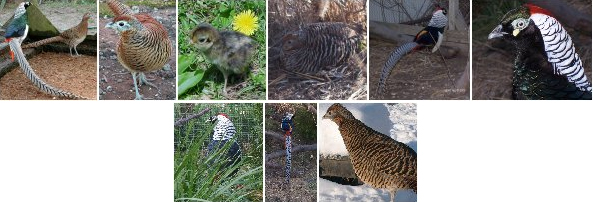
Bronze-tailed Peacock-Pheasant (Polyplectron chalcurum)
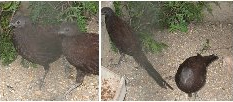 Other Names: Lesson’s or Sumatran Peacock-Pheasant.
Other Names: Lesson’s or Sumatran Peacock-Pheasant.
Range: Endemic to Sumatra.
Subspecies: Two, South Sumatran (P. c. chalcurum) and North Sumatran (P. c. scutulatum). There is debate on the validity of scutulatum as a subspecies.
Habitat: Montane forests.
Brief Description: One of the smallest of all pheasants. Only Polyplectron species with no ocelli. Both sexes show no crest and facial area feathered with no bare skin. Males have long pointed tails with metallic purple patches near tip. Females are similar to males, but smaller with a shorter tail. Differences between chalcurum and scutulatum are slight as there is a great deal of variations between individuals.
Status in Wild: Not yet listed as endangered, but range is small and always threatened by habitat loss.
Clutch Size: Two eggs
Incubation Period: 22 days
Mountain Peacock-Pheasant (Polyplectron inopinatum)
Other Names: Rothschild’s Peacock-Pheasant, Malayan Bronze-tailed Pheasant, Mirror Pheasant
Range: Central Malayan Peninsula
Subspecies: None
Habitat: Inhabits undisturbed mountain forests above 3,000 feet.
Description: The head and neck, breast and belly are gray, with no crest; mantle and wings with small bluish-green ocelli; mostly chestnut overall.
Description, Female: Similar to males but smaller, bright ocelli on upper back replaced with dark spots.
Clutch Size: 2 eggs
Incubation Period: 19 to 21 days

Germain’s Peacock-Pheasant (Polyplectron germaini)
 Other Names: Germain’s Pheasant
Other Names: Germain’s Pheasant
Range: Southern Vietnam
Subspecies: None
Habitat: Jungles and damp forests.
Brief Description: Generally darker than bicalcaratum. Males have large ocelli, the crest is very short and the facial skin is red. Females are smaller, also with red facial skin and ocelli on tail more pronounced than other members of this genus.
Status in Wild: Germain’s are considered vulnerable in the wild.
Breeding Season:Varies depending on region and climate. Birds in Florida and southern states may begin laying as early as February and May in the northern states.
Breeding Age: Usually not until they are two, but first years have proven fertile from time to time.
Clutch Size: Two creamy white eggs.
Incubation Period: About 22-23 days.
Grey Peacock-Pheasant (Polyplectron bicalcaratum)
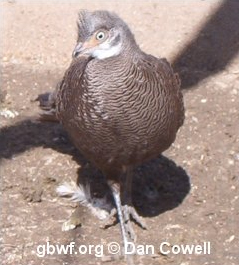 The Grey Pecock-Pheasant, also known as the Chinquis, is the national bird of Myanmar (Burma). There are four subspecies that are found in the tropical forests of south-east Asia. The Himalayan Grey P. b. bakeri is native to Bhutan and western Assam and the Burmese Grey P. b. bicalcaratum, which can be found in eastern Assam, Myanmar (Burma), Thailand and laos, are the two most often kept subspecies. The other subspecies the Ghigi’s Grey P. b. ghigii native to south-eastern China and the Lowe’s Grey P. b. bailyi whose range is not well known, but believed to be native to western Assam.
The Grey Pecock-Pheasant, also known as the Chinquis, is the national bird of Myanmar (Burma). There are four subspecies that are found in the tropical forests of south-east Asia. The Himalayan Grey P. b. bakeri is native to Bhutan and western Assam and the Burmese Grey P. b. bicalcaratum, which can be found in eastern Assam, Myanmar (Burma), Thailand and laos, are the two most often kept subspecies. The other subspecies the Ghigi’s Grey P. b. ghigii native to south-eastern China and the Lowe’s Grey P. b. bailyi whose range is not well known, but believed to be native to western Assam.
Variation in the subspecies is distinct, but it is tough to know which subspecies are currently being reared in American aviaries. bailyi and bakeri are the grayest in overall plumage (bailyi the markings and spots are a darker white or buff; bakeri darker than other, spots pure white), both have been imported and have probably crossed through the years. bicalcaratum is browner than the previous two, has also been reared in captivity; ghigi is similar to bicalcaratum, not as dark and the ocelli always surrounded by buffy gray border. I would to like hear from breeders who have been able to breed true lines.
This species can be distingushed from other Polyplectron species by the overall grayish brown plumage that is finely mottled with drak gray, white and buff. Males have metallic bluish-green ocelli on the wings and mantle. Each tail feather is marked with two large metallic green, with a tint of purple, ocelli. The cheeks and throat are white and he has a gray upright crest that leans forward in courtship displays. The female is much smaller and duller than the male. The ocelli is not near as bright or large as well.
Avicultural Data
These charming little birds do not require very large aviaries, but since they are a tropical species, they do require shelter during the coldest months. Some breeders use heated buildings when the temperatures drop below freezing for several days at a time, and others use dry straw and heat lamps. Being forest birds, be sure to provide plenty of shade during the summer months.
Greys will often become very tame and are not aggressive towards one another. You can breed two hens to one cock. They tend favor more live food than most species of pheasants, and they also enjoy many types of fruits and green food.
The breeding season begins in March and may last until July. The hen will only lay two eggs per clutch, but will lay several clutches if the eggs are collected. The hens also make great mothers and can be allowed to hatch their own eggs. The incubation period lasts about 21 days. Some breeders have difficulty in getting the chicks to start eating, this can be solved by placing a similar sized chick (golden or a bantam) in the brooder to teach the chicks to eat. Placing mealworms or other live “moving” food is another method to get them interested in eating. When the chicks are raised by their natural mother, you will notice that she will offer food to chicks from her beak, so you may want to use a pair of tweezers to offer the mealworms when raising the chicks in a brooder.

Malayan Peacock-Pheasant (Polyplectron malacense)
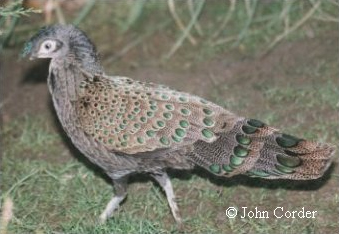 Other Names: Malaysian Peacock-Pheasant, Malay Peacock-Pheasant, Crested Peacock Pheasant
Other Names: Malaysian Peacock-Pheasant, Malay Peacock-Pheasant, Crested Peacock Pheasant
Subspecies: The Bornean Peacock-Pheasant (Polyplectron schleiermacheri) is sometimes considered a subspecies (Delacour 1977); later sources now list as a distinct species.
Range: Formerly found throughout the Malay peninsula from Thailand southward and believed to have been found on Sumatra. Now found only in central Malaysia.
Habitat: Lowland forests.
Brief Description: The male can be distingiushed from other polyplectron species in having an orange face, a longer (forward) crest and buff surrounding each ocelli on the mantle and wings. The hen lacks the crest; smaller than males, ocelli dark also with buff borders.
Status in Wild: Not yet endangered, but vulnerable due to small range and habitat loss.
Clutch Size: Usually just one egg.
Incubation Period: 22-23 days

Bornean Peacock-Pheasant (Polyplectron schleiermacheri)
Subspecies: The Bornean Peacock Pheasant is a lowland forest pheasant endemic to the island of Borneo and considered by some to be a full species; but when one is familiar with both Malay PP and this species, one cannot help to notice the peculiar similarities which make the Bornean PP seem more correctly considered to be a sub-species of P. malacense as in Smythies. These similarities include: very closely marked upperparts and tail (save for the shorter tail and black sub-terminal band), both with an orange facial and periophthalmic region and the diagnostic black (dark) ear coverts and the structures of both crest and ruff at the neck. Both the Malay and Bornean PP notably have a single-egg clutch, which is the norm for both species.
Range: Distributed historically and with museum specimens collected throughout various localities on the island of Borneo; in East, Central and Western Kalimantan, Indonesia and possibly existing in some locations in Sabah and Sarawak, North Borneo . Extremely rare and local in distribution.
Habitat: Lowland forests; where survival of the species probably depends upon the future of lowland primary forest below 300m.
Based on recent fieldwork and the extent of its remaining habitat, the population is estimated to be between 1000 and 2,499. The species is presumed always to have been difficult to detect, possibly reflecting very low densities.
Its ecological needs are poorly understood, research shows the species inhabits lowland plain and lowland dipterocarp forest on moderately fertile soils, probably avoiding wetter substrates in swamp-forest or near water bodies. Recent studies confirm the use of closed dry lowland dipterocarp forest habitats but a tolerance for regenerating habitats has yet to be properly established.
Description, Male: Crown short crested, barred pale grey and black, the centre glossed with green; ear-coverts black; a large ruff of disintegrated feathers barred black and pale grey, tips metallic violet-blue; upper parts as in P. m. malacense but much redder, the ocelli smaller and greener; tail shorter, the ocelli smaller, less closely connected on the coverts; there is a green ocellus on the outer web of the lateral rectrices and a dull black spot on the inner web; throat and upper breast pure white; sides of breast metallic blue-green; centre of the lower breast white, the rest of the upper parts black with whitish shafts and tiny vermiculations; under tail-coverts spotted brown and black patch near the tip. Iris – grey/white; facial skin orange-red; bill and feet dark grey. Like others of the genus, males can develop a number of spurs on each leg.
Description, Female: Similar to P. m. malacense but more reddish generally; tail shorter, the upper coverts are without blue ocelli, those of the rectrices is smaller and ill-defined; the rectrices are irregularly and coarsely barred with black. Iris light brown; facial skin orange, bill and feet grey. Hens do not develop spurs on their legs.

Palawan Peacock Pheasant (Polyplectron napoleonis)
Other Names: Napoleon’s Peacock-Pheasant; The specific name napoleonis now has priority over emphanum. Source – Dickinson, E. C. (2001): The correct scientific name of the Palawan Peacock-Pheasant is Polyplectron napoleonis.
Range: The island of Palawan in the Philippines.
Subspecies: There are no subspecies recognized, but males with white supercillia (often referred to as double-barred in captivity) are sometimes given subspecies status as nehrkornae. This is disputed and the variation is probably insignificant.
Habitat: Forested areas
Description: Unmistakable from the other species in the genus. The crest is long and pointed which is dark metallic green as is the crown and neck; the facial skin around the eye is bright red with a white patch under the eye. Some males will have another white patch or bar above the eye that is parallel with the patch below (sometimes extending down the neck), these birds are often referred to as “Double-barred” (see subspecies above). The breast, mantle, flanks and wings are dark metallic greenish-blue and black; there are no ocelli on the rump, rather solid vermiculations of white, black and chestnut. The tail is similar in color with large blue-green ocelli sperated by a black band; the tip of the tail is buff.
Description, Female: Very drab in comparison to the male. Her crest is shorter and often held flat; her face is pale gray that extends from above the eyes to the throat. The rest of the plumage is dark brown, with no ocelli.
Breeding Season: Begins in March in warmer climates and can last into August.
Breeding Age: Males can be sexually mature the first year, although it may take up to three years to fully develop the adult plumage; hens will not often lay until they are two.
Clutch Size: 2 to 5 eggs; buff white in color.
Incubation Period: 18-19 days.
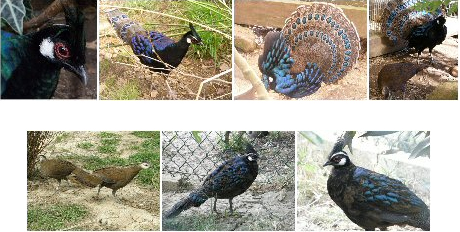
Great Argus (Argusianus argus)
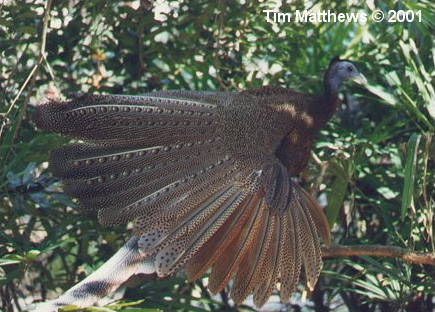 Other Names: Argus Pheasant, Argus
Other Names: Argus Pheasant, Argus
Subspecies: There are living two subspecies, the Malaysian Great Argus (A. a. argus) can be found in Malaysia and Sumatra and the Bornean Great Argus (A. a. grayi) found on Borneo. A. a. bipunctatus is known only from a portion of a primary feather of uncertain origin. Believed to be extinct and was found on Tioman Island off the Malay Peninsula.
Habitat: Forests, from sea-level to 4,000 feet.
Description: One of the most unusual of all bird species, males are unmistakable with massive primary, secondary and tail feathers. The face is blue, the crown is black with a distinctive short crest. The upperparts are brown, finely mottled with buff; iridescent ocelli can be found on the wings and tail. The wings can continue to grow until the bird reaches its sixth year. A. a. grayi is slightly smaller than A. a. argus and can be distingiused by the burnt orange on the breast and neck and with more white spotting. Females are similar, but smaller than males; also lack the ornate tail and wings.
Status in Aviculture: Very rare in private aviculture.
Clutch Size: 3 to 4 eggs
Incubation Period: 25 days
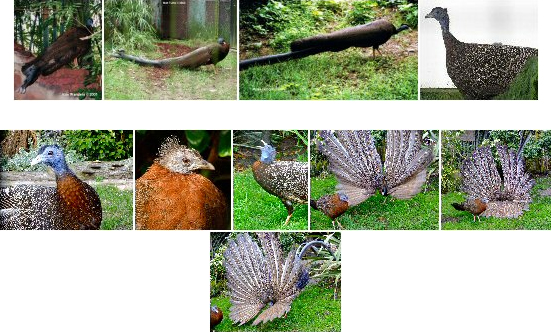
India Blue Peafowl (Pavo cristatus)
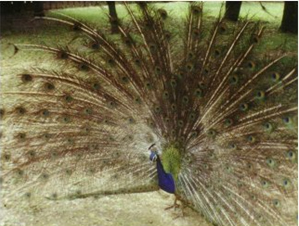 Other Names: India Blue Peafowl, Blue Peafowl, Common Peafowl
Other Names: India Blue Peafowl, Blue Peafowl, Common Peafowl
Subspecies: Monotypic, but a host of mutations exist.
Range: Pakistan, India and Sri Lanka. Many feral populations exist throughout the world.
Habitat: Varied, deciduous forests, cultivated lands and near villiages.
Description: Unmistakable, could only possibly be confused with the Green Peafowl. Males are large, with a long ornate tail used for courtship. Distinguishable from Pavo muticus in having a royal blue neck and breast; facial skin is white, crest is fan shaped. Immature males have varied plumage, but will have the fan-shaped crest and mottled blue upperparts. Second year males show a smaller tail, often without ocelli. By the third year, they reach full plumage and sexual maturity. The tail may continue to grow for another two to three years. Males will molt and lose their tails each year in late summer.
Description, Female: Rather drab in comparison to the male. Facial skin and crest shape same as in male, but crest is brown. The throat is white, breast and back of neck green; abdomen pale buff to cream, rest of body light brownish-gray.
Status in Wild: Very common in most areas of the natural range.
Interesting Facts: The National Bird of India. This species is sometimes simply called the Peacock; the peacock is the male, females are known as peahens and the young are peachicks. Pavo is Latin for peafowl. cristatus is Latin for crested. Peafowl have been kept in captivity for many centuries and have been reported in ancient Egyptian, Roman and Greek history.
Captive Diet: When on free range, will eat just about anything! A balanced diet should be offered to include poultry pellets and grain. Birds housed in aviaries should be offered greens and live food when available.
Breeding Season: Varies depending on region. In Missouri, can begin as early as March. Egg laying is usually complete by the time the males drop their tails in July, but there are exceptions!
Breeding Age: As a rule, males are not mature until their third year, but second year males are often fertile. I have heard of first year hens laying, but the second year is the average.
Clutch Size: Average clutch sizes in the wild are 6 to 8. Captive birds will lay up to three clutches.
Incubation Period: 28 days.

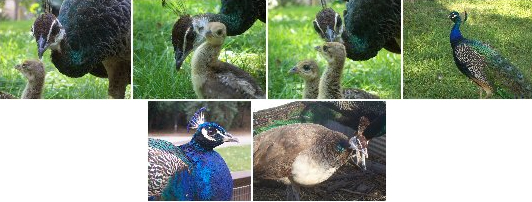
Green Peafowl (Pavo muticus)
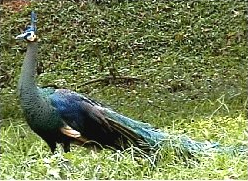 Other Names: Green-necked Peafowl, Burmese Peafowl, Java Peafowl
Other Names: Green-necked Peafowl, Burmese Peafowl, Java Peafowl
Subspecies: There are three subspecies: (P. m. muticus) native to Malaysia and Java, (P. m. spicifer) from northeastern India & northwestern Myanmar (now believed to be extinct) and (P. m. imperator) found in Indo-China.
Range: South-east Asia
Habitat: Forests and scrubland.
Description: A very beautiful bird, more upright in stance than the India Blue. The overall coloration of metallic green feathers tipped with black, give the appearance of scales. The crest of this species stands nearly erect compared to the broad crest of its Indian relative; bare skin of blue and yellow beneath the eye, dark bluish-green metallic feathers on the remainder of the head and neck. The wing coverts are dark green and blue, with the flight feathers chestnut. The tail is similar to the India Blue, but is somewhat darker at the base and has a golden sheen throughout the train. There is slight variation between the subspecies: muticus is the brightest green of the three with bright iridescent blue and green wing coverts; spificer is much duller and there is more blue in the plumage than muticus and imperator; imperator is similar to muticus, but can be distinguished by having darker flanks, abdomen and secondaries and much lighter facial skin.
Description, Female: Unlike the India Blue, the hen of this species is similar to the male. She lacks the brilliant sheen and gloss of the male, but does have the scaling of the feathers. Her tail is also fairly long. Some hens may develop spurs.
Breeding Season: Late April to June
Breeding Age: Third year, however, second year hens may lay fertile eggs if kept with an older male.
Clutch Size: 4-6
Incubation Period: 26-28; the chicks grow quickly, able to fly good distances at two weeks of age.
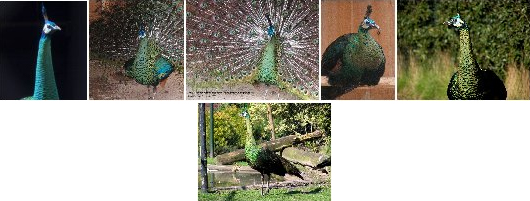
Congo Peafowl (Afropavo congensis)
Other Names: Congo Peacock
Subspecies: None recognized.
Range: The Congo Basin in central Zaire (now known as Democratic Republic of the Congo).
Habitat: Rainforests
Description: The males are mostly dark blue all over with a metallic green and purple tinge, and have a much shorter tail (with no ocelli) than the Asian species. The upright crest is white in front with a few dark feathers behind. The throat is reddish-brown. The hen is also very different from Asian peafowl. She has a bright chestnut breast, underparts and forehead, while the back is metallic green.
Status in Wild: Unknown
Interesting Facts: Not known to science until the 1930s. This species shows characteristics of both peafowl and guineafowl, perhaps a historic link between the two families.
Misc. Aviculture Notes: In captivity, they are known to lay their small clutches of 2 to 4 eggs in an elavated nest box or on platforms placed about five feet from the ground. Incubation lasts about 26 days incubated by only the female. Chicks rely heavily on insects as their diet for the first week of life. Females reach sexual maturity the first year for females and males nearly two; adult plumage is not attained until the second year.

Game Bird Starter Feed
| Crude Protein % |
30.5 |
| Crude Fat % |
5.0 |
| Crude Fiber % |
4.2 |
| Metabolizable Energy kcal/kg |
2600 |
| Ash |
6.9 |
Feeding Instruction: Feed free choice to birds as sole ration until 6 weeks age. Start with a small amount on paper or cardboard to ensure all birds begin eating.
Game Bird Breeder Feed
| Crude Protein % |
20.0 |
| Crude Fat % |
4.0 |
| Crude Fiber % |
4.0 |
| Metabolizable Energy kcal/kg |
2575 |
| Ash |
10.3 |
Feeding Instruction: Feed from 4 weeks before laying until after breeding season, then after feed Yembroos Game Bird Maintenance Feed
| Crude Protein % |
12.8 |
| Crude Fat % |
4.4 |
| Crude Fiber % |
4.8 |
| Metabolizable Energy kcal/kg |
2800 |
| Ash |
4.4 |
Feeding Instruction: Feed ad libitum to non breeding adult birds
| Crude Protein % |
17.0 |
| Crude Fat % |
4.0 |
| Crude Fiber % |
7.0 |
| Metabolizable Energy kcal/kg |
2575 |
| Ash |
10.3 |
Feeding Instruction: Feed from 4 weeks age for all species of Game Birds and other Exotic Birds. Maintenance Ration in Mixed Grain Format for Birds.
| Crude Protein % |
18.0 |
| Crude Fat % |
3.0 |
| Crude Fiber % |
6.0 |
| Metabolizable Energy kcal/kg |
2575 |
| Ash |
10.3 |
Feeding Instruction: Feed from 4 weeks before laying until after breeding season, then after feed Yembroos Game Bird Maintenance Feed
| Crude Protein % |
28 |
| Metabolizable Energy Kcal/lb |
1340 |
| Calcium (%/lb) |
1.30 |
| Non Phytate Phosphorous (%/lb) |
0.60 |
| Sodium (%/lb) |
0.18 |
| Crude Protein % |
24 |
| Metabolizable Energy Kcal/lb |
1340 |
| Calcium (%/lb) |
1.10 |
| Non Phytate Phosphorous (%/lb) |
0.48 |
| Crude Protein % |
18 |
| Metabolizable Energy Kcal/lb |
1250 |
| Calcium (%/lb) |
0.85 |
| Non Phytate Phosphorous (%/lb) |
0.42 |
| Sodium (%/lb) |
0.18 |
| Crude Protein % |
16 |
| Metabolizable Energy Kcal/lb |
1270 |
| Calcium (%/lb) |
2.6 |
| Non Phytate Phosphorous (%/lb) |
0.42 |
| Sodium (%/lb) |
0.18 |
| Crude Protein % |
28 |
| Metabolizable Energy Kcal/lb |
1315 |
| Calcium (%/lb) |
1.20 |
| Non Phytate Phosphorous (%/lb) |
0.50 |
| Sodium (%/lb) |
0.18 |
| Crude Protein % |
19 |
| Metabolizable Energy Kcal/lb |
1325 |
| Calcium (%/lb) |
1.0 |
| Methionine (%/lb) |
0.46 |
| Methionine + Cystine (%/lb) |
0.80 |
| Crude Protein % |
20 |
| Metabolizable Energy Kcal/lb |
1340 |
| Calcium (%/lb) |
3.0 |
| Non Phytate Phosphorous (%/lb) |
0.45 |
| Sodium (%/lb) |
0.18 |
| Crude Protein % |
26 |
| Metabolizable Energy Kcal/lb |
1275 |
| Calcium (%/lb) |
0.90 |
| Lysine (%/lb) |
1.27 |
| Crude Protein % |
24 |
| Metabolizable Energy Kcal/lb |
1300 |
| Calcium (%/lb) |
0.85 |
| Methionine (%/lb) |
0.48 |
| Methionine + Cystine (%/lb) |
0.85 |
| Crude Protein % |
20 |
| Metabolizable Energy Kcal/lb |
1315 |
| Calcium (%/lb) |
0.80 |
| Vitamin A IU/lb |
2065 |
| Vitamin D ICU/lb |
637 |
| Crude Protein % |
18 |
| Metabolizable Energy Kcal/lb |
1270 |
| Calcium (%/lb) |
2.60 |
| Vitamin K mg/lb |
1.0 |
| Thiamin mg/lb |
1.0 |
| GENERAL DETAILS |
Specification |
| Ingredients | Corn Gluten Meal, Soy Meal, DDGS, Pluses, Essential Amino Acids, Vitamins, Minerals, Trace Minerals, Toxin Binders and Mold Inhibitor |
| Ingredient Profile | 100% Vegetarian |
| Moisture (% Maximum) | 12 |
| Product Form | Seed Mixture / Pellet Form |
| Product Branding | Yembroos® |
| Net Weight | 39 Kgs When Packed |
| Product Pricing | On Unit Basis (for each 39 Kgs Packing) |
| Production Capacity per Day | 650 MT/Day |
| Factory Visit | Not Permissible |
| Fumigation | Aluminum Phosphide or Methyl Bromide (or any as per buyer specification) |
| Clinical Test Methodology | As per IS:2052 Proximate Analysis on Dry Matter Basis |
Yembroos Animal Feeds India Private Limited is a leading Game Bird Feed Manufacturer, Exporter, Supplier, Distributor, Vendor, Company, and Producer located in Thrissur District of Kerala. Our wide and high-precision product range defines us among the most renowned Game Bird Feed Manufacturers, Exporters, Suppliers, Distributors, Vendors, Companies, and Producers in India. We manufacture a complete range of Game Bird Feeds including Game Bird Starter Feed, Grower Feed, Breeder Feed, and Layer Feed. In addition, we are also recognized as a prominent Bird Feed Manufacturer, Exporter, Supplier, Distributor, Vendor, Company, and Producer in India, offering a diverse portfolio of high-quality avian nutrition solutions. Yembroos has further pioneered as a Bird Seed Manufacturer, Exporter, Supplier, Distributor, Vendor, Company, and Producer, delivering superior-grade bird seeds tailored for both international and exotic bird species, reaffirming our position as one of India’s most trusted names in the bird and game bird nutrition industry.
